The ongoing project of “playing house/museum” has been full and fulfilling this fall. Amid the deluge of SAIC class visits and projects, we squeeze in visitors from the public. A grateful guest sent a note of thanks, bolstering our belief that Brown’s Artists’ Museum of Chicago is a worthwhile endeavor.
“…i can’t describe how i felt in that space or how it makes me feel right now just thinking about it, but it’s physical and in my heart and my stomach and my throat. it’s these kind of experiences that make me feel connected to other people and make the world less lonely. very inspiring…”
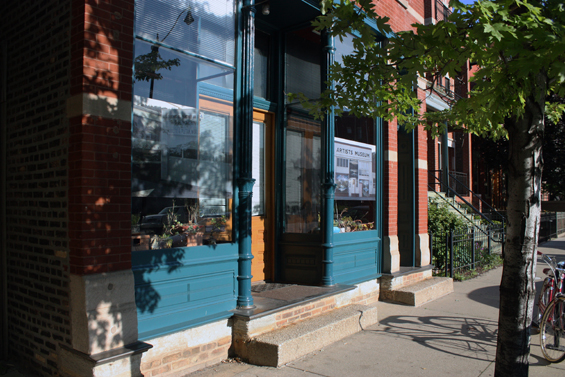
This semester we hosted 58 class visits. In addition to regaling 40 Research Studio classes, we hosted several intriguing class projects, some for a single day, and some spread out over the semester.
 Jim Elniski and Research Studio students
Jim Elniski and Research Studio students
By the third week of the semester Tim Parsons’ and Dan Price’s Thing Lab class (AIADO) had created ambitious sculptures, which they arranged around the orientation/project space. The day entailed intensive thought about objects-recently-created, curiously heightened by the proximity of praying hands objects and the presence of the collection upstairs.
 Tim Parsons and Dan Price, Thing Lab students at work
Tim Parsons and Dan Price, Thing Lab students at work
Mark Jeffery’s Performing the Document class occupied 1926 for the first four Mondays of the semester. Delving into the histories, ideas, and associations in objects, arrangements, spaces, and documents, performances were created and performed throughout the entirety of 1926 N. Halsted St.
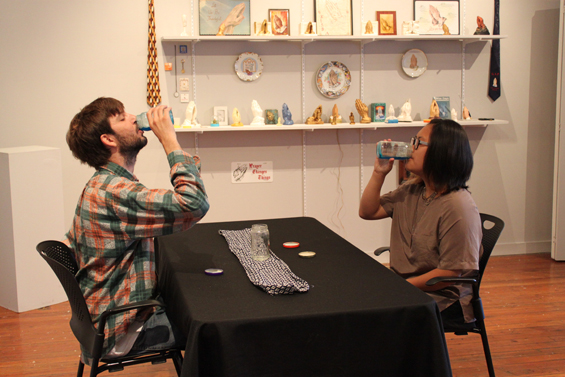 Performing the Document students Kurt Peterson and Jenny Kim
Performing the Document students Kurt Peterson and Jenny Kim
 Stephanie Krim creates a collection hoax
Stephanie Krim creates a collection hoax
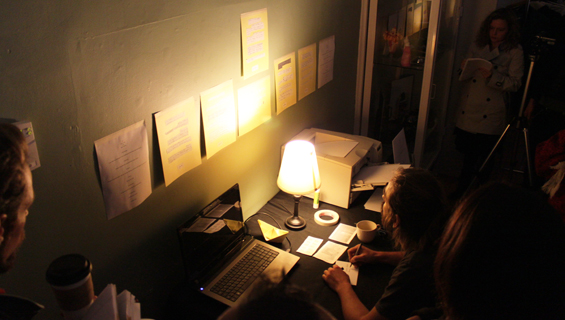 Gunter Baumann’s all-day postcard generating machine.
Gunter Baumann’s all-day postcard generating machine.
Holly Warren was saddened that the rocket juniper Roger planted c.1994 will be removed next summer. (The project to replace the rear porch and stairs, to comply with City Code, will likely necessitate removal of the tree.) The tree blew over in a storm in summer 2012, but continues to thrive in its reclining position.
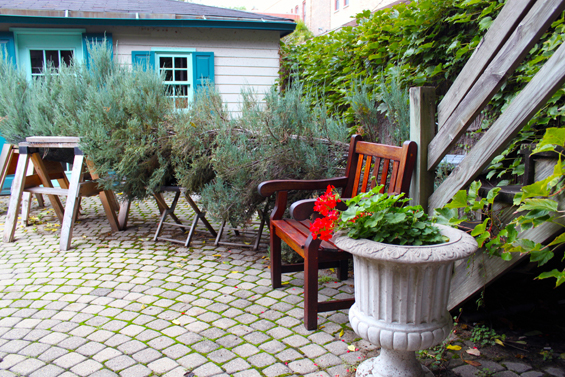
Holly ignited the idea of preserving it through grafting branches onto bonsai, which she ceremoniously demonstrated. We’ll spend the winter researching methods to graft and propagate from this tree, and if at all possible, to save it in place.
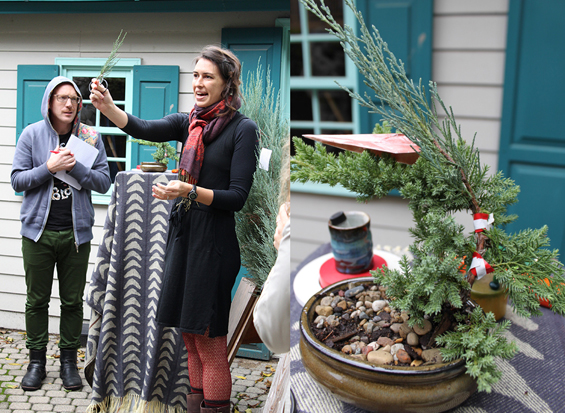
Holly’s project intuited Brown’s final series of five sublime paintings of bonsai in 1996. Surely related to his cultivation of bonsai in his La Conchita, California garden, these paintings reverse the scale of bonsai as miniature trees, positioning miniature humans against landscapes with monumental bonsai. Brown imbued these works with the feeling of a departure into a different realm, anticipation of a different dimension.

Roger Brown, Bonsai series, left to right:
Bonsai #1, presumably; we have an image but no documentation of this painting
Bonsai #2, Climbing with the Cascade (Kengai) 1997, oil on canvas, 72 x 48 in.
Bonsai #3, Ishitsuki, Root Over Rock 1997, oil on canvas, 72 x 48 in.
Bonsai #4, Sekijoju, Root over Rock 1997, oil on canvas, 48 x 48 in.
Bonsai #5, Literati (Bunjing) 1997, oil on canvas, 72 x 48 in.
Patricia Rieger’s Curious Intimate Object (Ceramics) class explored objects and settings throughout the collection, as springboards for making, and locations for critiquing their curious, intimate objects. Students installed their works throughout the collection, temporarily, making it a new place in many small ways, introducing fresh reflections on objects and the creative process.
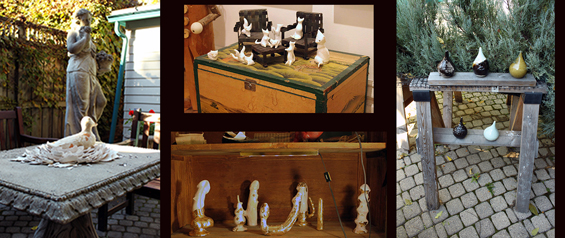 left to right, works by Haley Hodge, Doris Richardson (top), Katie Doyle (bottom), and Aileen Berg.
left to right, works by Haley Hodge, Doris Richardson (top), Katie Doyle (bottom), and Aileen Berg.
Modeling for Sculpture
Laura Prieto-Velasco and her Modeling for Sculpture students arrived one day armed with an imposing 3-d scanner. Students explored the collection, found objects of interest, and put the scanner to work turning physical info into digital data. They spent the ensuing weeks manipulating the objects’ “dna” into original objects in a variety of media. Their sculptures, carrying traces of their parentage, will be on view at 1926 in an upcoming exhibition, details forthcoming.
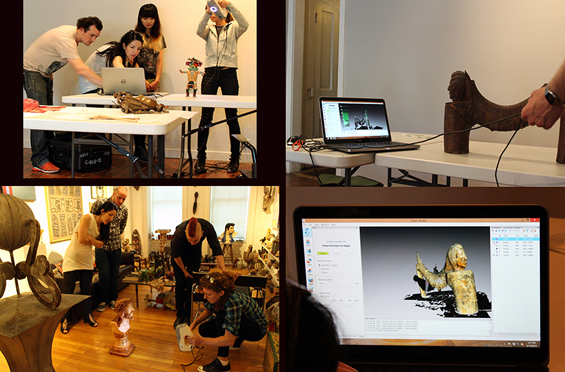 Modeling for Sculpture in action.
Modeling for Sculpture in action.
Punks!
Peter Exley’s Research Studio class showed up one evening with legendary Mekons guitarist and artist Jon Langford in tow. Langford regaled us with dark tales of his attempts to penetrate the realms of art and music in 1970s London, Manchester, and Leeds.
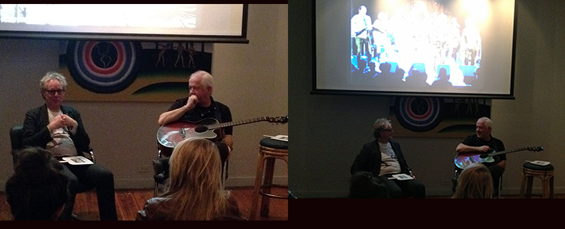 Peter Exley and Jon Langford.
Peter Exley and Jon Langford.
That was just a warm-up, as Langford returned with Sally Timms and Janet Bean, as The Freakons…. giving Exley’s class and lucky select guests a heartfelt and rousing performance of mining tunes, on the last day of the semester. Eternal thanks to The Freakons!!
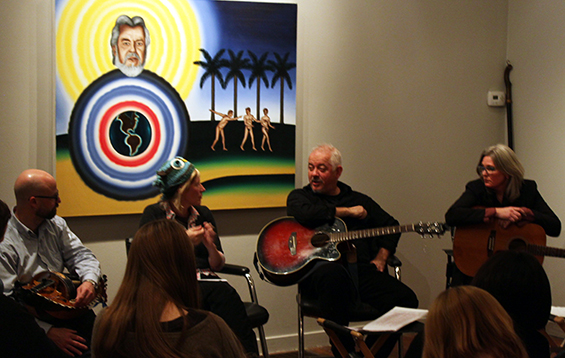
This semester’s exhibition Hands Together: An Icon Incarnate, lead us into intense thinking and talking about the curious co-mingling of fine art, popular culture, private devotion, appropriation, collecting, consideration of objects, and diverse portrayals of the human hand. Please see the earlier post for a guided tour through the exhibition. Inspired collectors Rolf and Maral seek the perfect new home for the collection and we’re currently considering interesting possibilities…
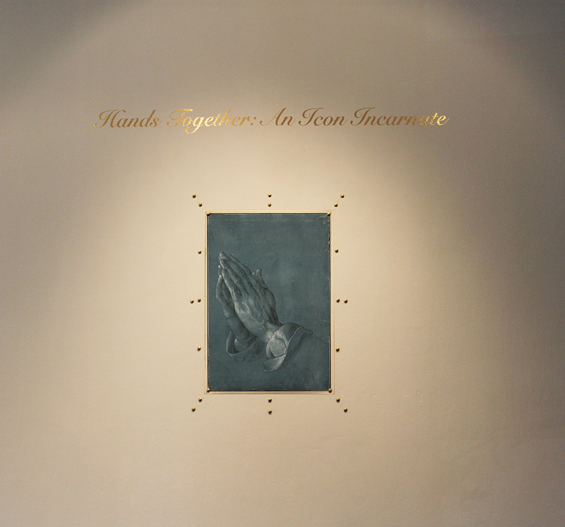
Upcoming…
Nick Lowe’s spring 2014 Collections Practicum class will spend most of the semester in a long-awaited project to completely revise and reinvent the RBSC master collection catalog. (A dream to come true for one chagrined and humble curator….)
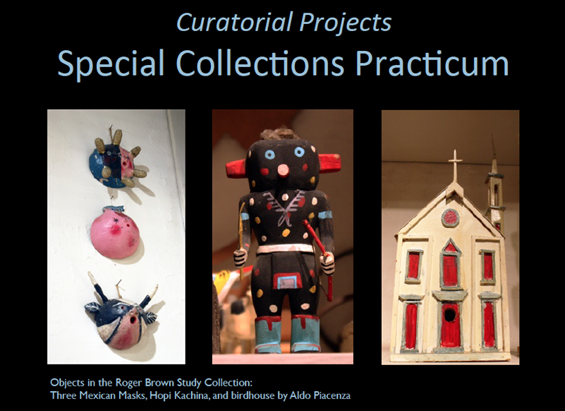
Staff projects
All hands were on deck hosting the many class tours but in our spare time we gained traction with a few projects:
James kicked all data storage and retrieval systems, training, and project organization systems into a stellar level of on and offline organization. He just completed a 2 week residency at the Roger Brown New Buffalo, MI compound, where he spent his days winding electromagnets and modifying cathode ray tube monitors for an upcoming installation and his evenings researching and writing a paper examining the renewed potency of analog audio/video aesthetics in the context of digital immateriality.
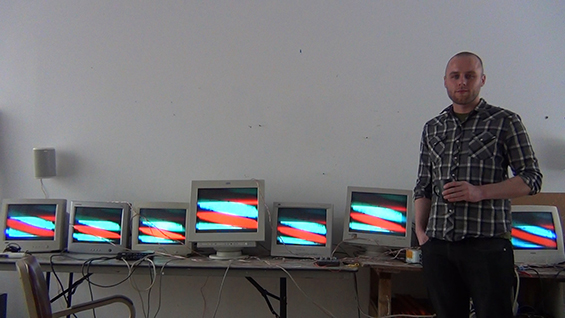
Nick Lowe continued to organize La Conchita collection objects at 1926 and worked with Lisa and Patrick Jones to survey the collection in storage at 43rd Street, as we consider the future of this collection.
Ariel Fang (undergrad senior) worked on several aspects of the Roger Brown master database, and did all gallery preparations.
Molly Hewitt (undergrad senior) took a much-needed sabbatical! (But we get her back in winter and spring semesters.)
Danyu Xu (Arts Admin 2nd year grad) scrambled to keep up with scanning archival materials for independent researchers.
Olivia Junell (Art History/Arts Admin dual degree 1st year grad) researched and rewrote the Roger Brown/RBSC Wikipedia page, soon to be online.
Annette Lepique (Art History 1st year grad) promoted the Hands Together exhibition through an FNews video interview, and organized images of Roger Brown prints.
Gabe Stallings (Sculpture grad 1st year) recorded measurements and exhaustively photographed the rear stairs and porch, to document this original feature before it’s replaced next summer.
And Lisa worked on refining the 1926 / RBSC juggling act…
1926 / facilities
Let there be Light… The den, living room, central stairs and front hall have been transformed, almost miraculously, with LED lighting. We can finally see the objects (and the dust) and were able to discard many clumsy clip-on lamps.
Let there be sound… Subtle background music provides an essential ambiance for guests touring the collection. To date we’ve used an ancient boom box on the kitchen floor–-quaint but hardly ideal. IRFM (Instructional Resources Facilities Management) staff ordered tiny Sonos speakers for the den, living room, hall, and bedroom. The speakers will be connected wirelessly to a laptop on the first floor, from which we will be able to program sound to each speaker independently. We look forward to the unlimited possibilities of curating sounds and music, from Roger’s long-playing record albums and other sources.
Let there be Code Compliance…We’re working with IRFM on the plan to replace the back porch and stairway with a new wood and metal porch/stairway that will conform to City of Chicago code.
Let there NOT be rats… IRFM staff worked hard to repair the garage door and walls, and the garage is now fortunately off limits to the rodents.
Collection / Archive
Thirty-six Yoakum drawings were reinstalled after a year of rest in the archive. We determined a rotation period of 5-6 months per year, annually. We plan to have the drawings on view from September through February. We’ll put them to rest from March through August, and create room interpretation with video and slides shows on two flat screen monitors.
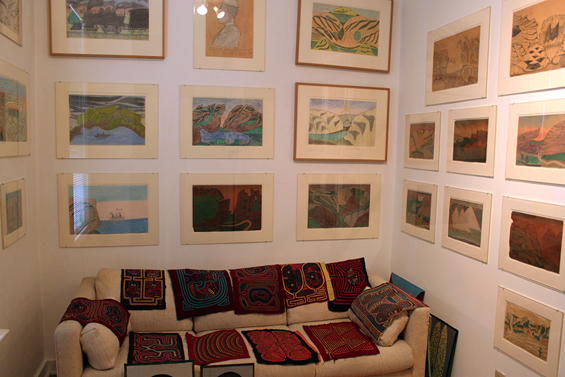
Outreach, colleagues, happenings
The Open Eye series of exhibitions, with its grand centerpiece, Ray Yoshida’s Museum of Extraordinary Values opened at the John Michael Kohler Arts Center (Sheboygan, WI) to much fanfare in October. Nearly thirty Yoahida family members––many from Hawaii––attended the opening, to honor their beloved “uncle.” Expertly curated by Arts Center curator Karen Patterson (SAIC alumna and former RBSC staff member), the exhibition is an outstanding tribute to Ray’s life and work, his “open eyes,” and his remarkable legacy.
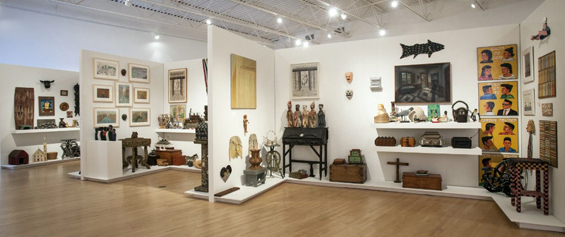 Installation view, Ray Yoshida’s Museum of Extraordinary Values, John Michael Kohler Arts Center, Sheboygan, WI, through January 19, 2014.
Installation view, Ray Yoshida’s Museum of Extraordinary Values, John Michael Kohler Arts Center, Sheboygan, WI, through January 19, 2014.
We made friends with SAIC visiting artist Jane Wildgoose, founder/operator of the Wildgoose Memorial Library in London, “…a private reference resource which may be accessed by persons wishing to consult & make free associations on the subjects pertaining to the mysteries of THE LVING IN RELATION TO THE DEAD, AND ON MEMORY AND IMMORTALITY.” Ms. Wildgoose was enchanted by the RBSC and we immediately began scheming to join forces in the further adventures of artists’ museums and collections.
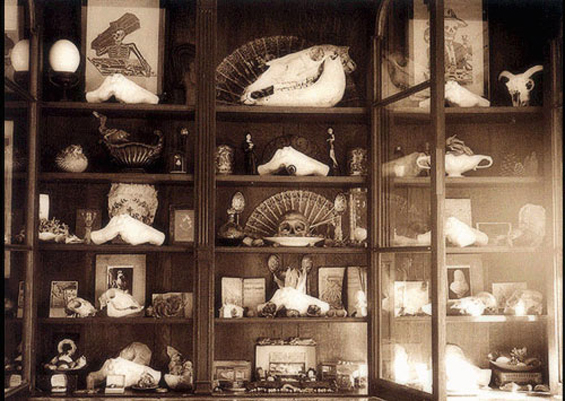 The Wildgoose Memorial Library
The Wildgoose Memorial Library
SAIC installed a Donor Recognition Wall in SAIC’s LeRoy Neiman Center in the Sharp Building, 37 South Wabash Avenue. Roger Brown is recognized in the Chairman’s Circle, for donors of $5,000,000 or more. Thank you Roger Brown.
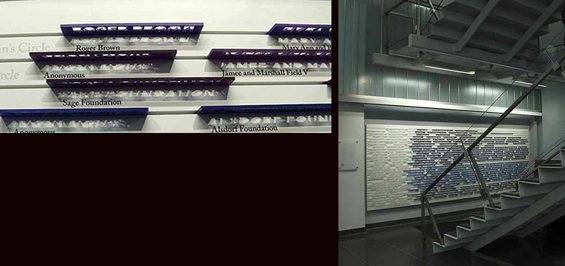 Photo: Nicholas Lowe
Photo: Nicholas Lowe
And as always, we send our warm greetings to Greg and Benedicte Brown, and to all Brown & Palmer family members far and wide.
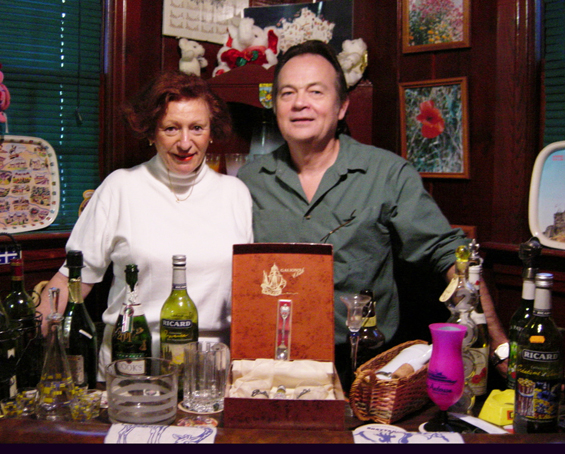
and happy holidays to all…
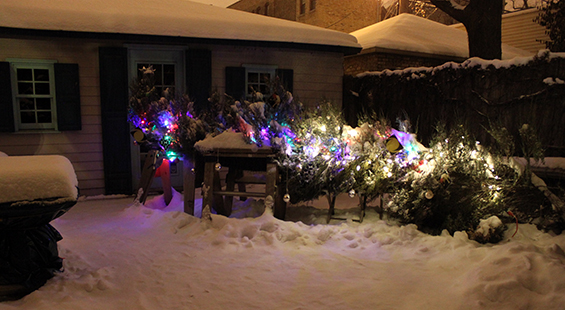
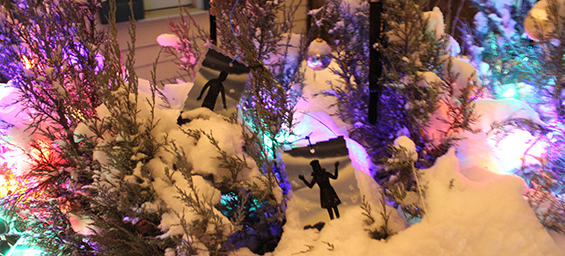
Lisa Stone, December 2013
RBSC staff member Annette LePique recently discussed the exhibition Hands Together: An Icon Incarnate with RBSC curator Lisa Stone and collector Rolf Achilles for SAIC’s F Newsmagazine. The exhibition will be on display at the RBSC through December.
https://vimeo.com/77836227
Annette LePique is currently a curatorial assistant at the RBSC, a graduate student in the Art History department at SAIC, and a regular contributor to F Newsmagazine. Her complete list of writings and interviews for F News can be found here.
Hands Together: An Icon Incarnate
A modest exhibition at the Roger Brown Study Collection
August 26 – December 16, 2013
In 1508 Albrecht Dürer highlighted with white paint a black ink brush drawing of two hands, palm to palm, on handmade paper tinted a very uniform blue. It was a study for an apostle’s hands for his Heller Altarpiece. This study of his left hand as seen in two mirrors evolved into an iconic image of prayer.
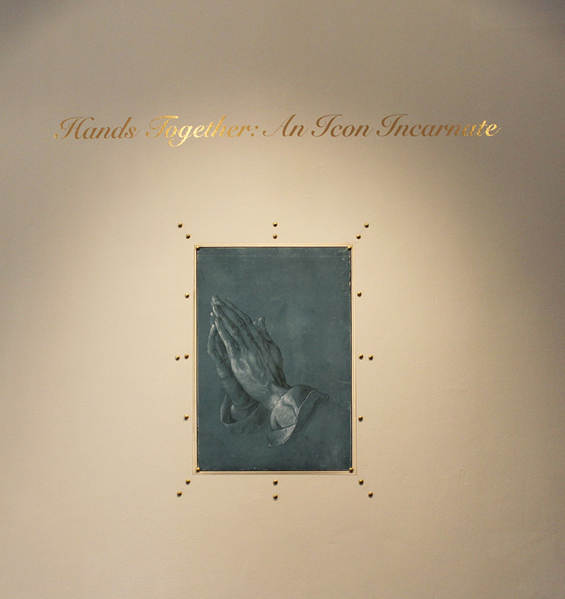 Reproduction: study for Apostle’s hands, also known as “Praying Hands” 1508, brush, gray and white ink, gray wash on blue prepared paper, 29.1 x 19.7 cm. Original drawing in the collection of the Albertina, Vienna. Reproduced with permission on banner material, 23 x 16 inches.
Reproduction: study for Apostle’s hands, also known as “Praying Hands” 1508, brush, gray and white ink, gray wash on blue prepared paper, 29.1 x 19.7 cm. Original drawing in the collection of the Albertina, Vienna. Reproduced with permission on banner material, 23 x 16 inches.
In 1871, after many years of being preserved in the Albertina, Dürer’s sketch was shown to the public for the first time. No one paid any particular attention. Twenty-five years later, in 1896, the sketch was reproduced for the first time. The Praying Hands image became an immediate sensation and reproductions by scores of printers found a wall-spot in many German homes.
This new domestic image quickly spread to the United States, brought by many thousands of German immigrants. By the mid-1950s the study sketch from 1508 shows up in 3-D as cast plaster, candles, bookends, lamp stands and is claimed as a symbol by Baptists and Fundamentalist Christians.
 Detail view, praying hands objects at the RBSC.
Detail view, praying hands objects at the RBSC.
This display of some 50 objects from the collection of Rolf Achilles and Maral Hashemi reflects Dürer’s hands in the hands of an adoring public. Through it we celebrate the conversation between “fine art” and objects from popular culture––generally considered “not-so-fine-art”–– brought together on neutral ground.
 Rolf Achilles and Hands Together
Rolf Achilles and Hands Together
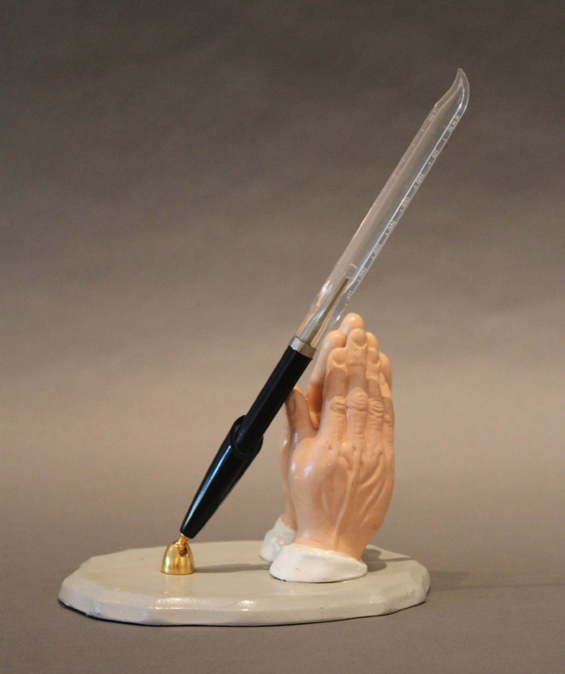 Pen holder, artist & date unknown; plaster, paint, metal, and plastic
Pen holder, artist & date unknown; plaster, paint, metal, and plastic
 Pencil sharpener, artist & date unknown; plastic
Pencil sharpener, artist & date unknown; plastic
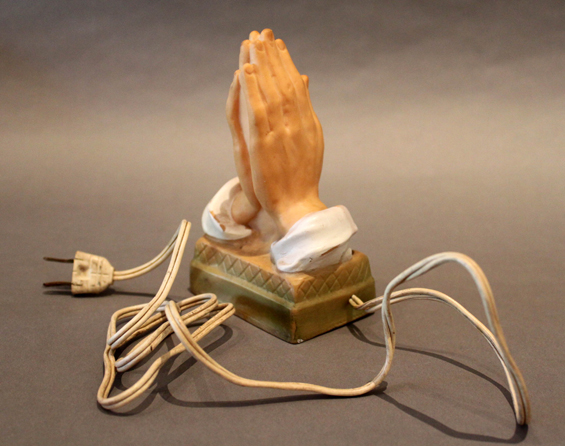 Night light, artist & date unknown; cast rubber, paint, electric cord and bulb
Night light, artist & date unknown; cast rubber, paint, electric cord and bulb
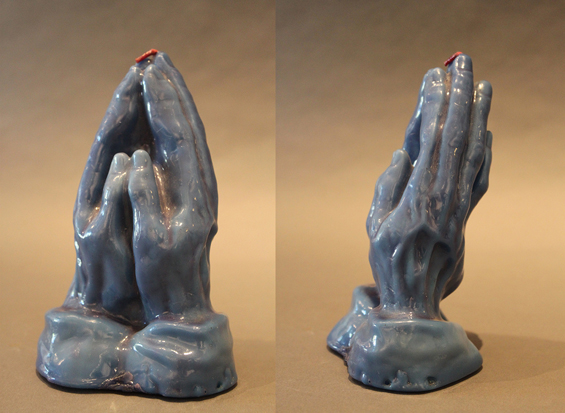 Candle, Paraffinalia Fine Candles, IX 89, wax, paper label, wick.
Candle, Paraffinalia Fine Candles, IX 89, wax, paper label, wick.
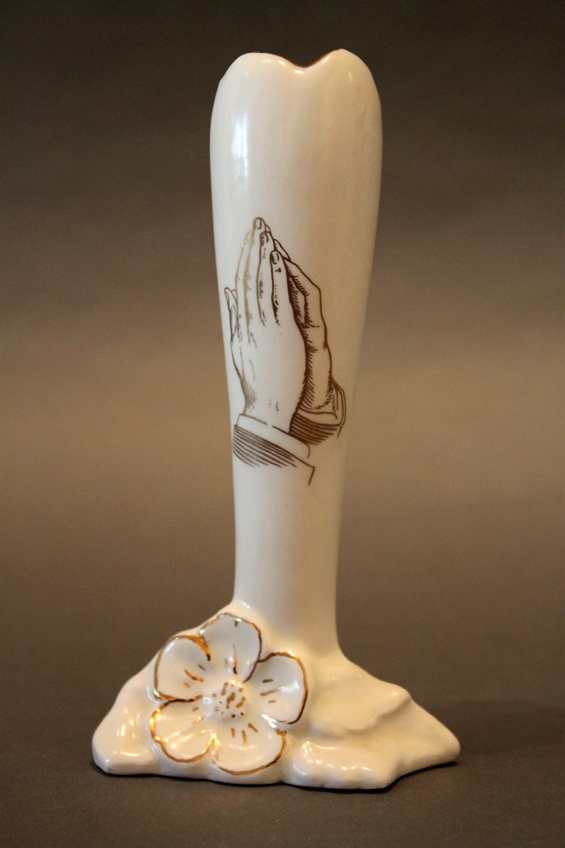 Bud vase, artist & date unknown; cast porcelain, glaze and decal.
Bud vase, artist & date unknown; cast porcelain, glaze and decal.
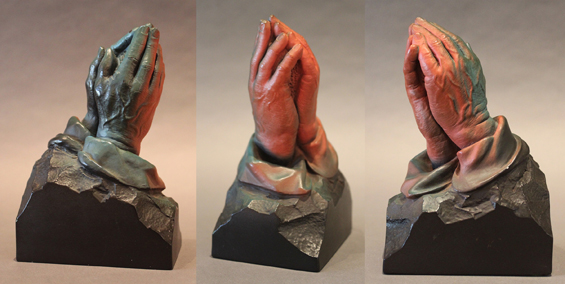 Praying Hands by Victor © Creative Arts, Inc. Date unknown, cast resin.
Praying Hands by Victor © Creative Arts, Inc. Date unknown, cast resin.
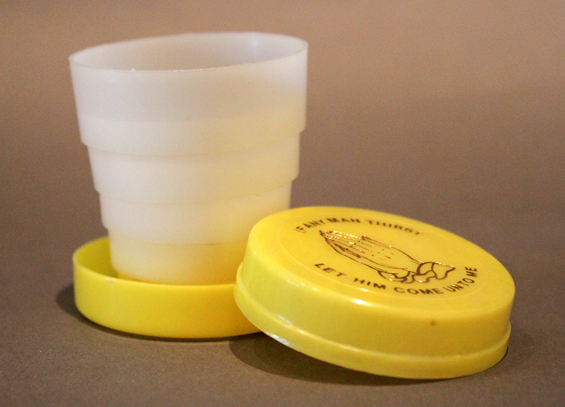 Collapsible cup, “If any man thirst let him come unto me,” date unknown, Made in Hong Kong, plastic and paint.
Collapsible cup, “If any man thirst let him come unto me,” date unknown, Made in Hong Kong, plastic and paint.
 Praying hands statue, © 1989 922 Universal Statuary, cast resin, paint, felt, and paper labels. Made in USA.
Praying hands statue, © 1989 922 Universal Statuary, cast resin, paint, felt, and paper labels. Made in USA.
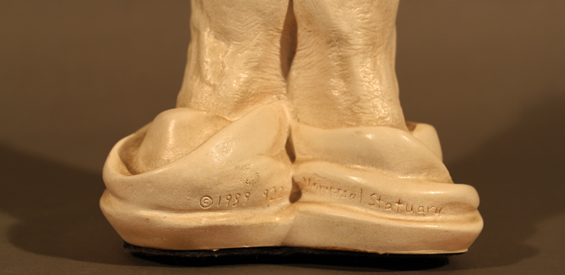 Detail, Praying hands statue base (white), © 1989 922 Universal Statuary, cast resin, paint, felt, and paper labels.
Detail, Praying hands statue base (white), © 1989 922 Universal Statuary, cast resin, paint, felt, and paper labels.
Made in USA.
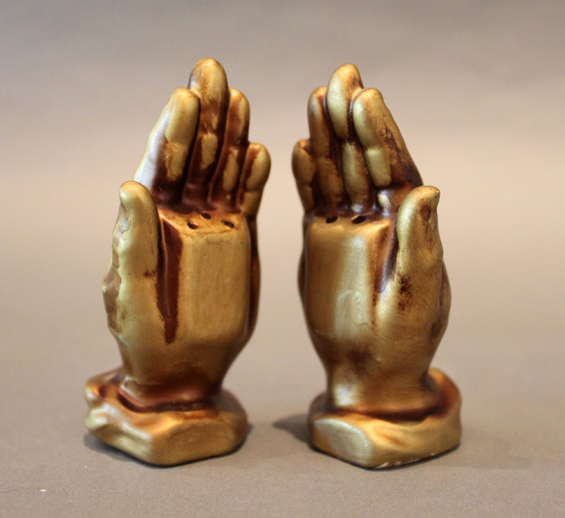 Salt and pepper shakers, artist & date unknown, slip cast ceramic and paint, plastic stoppers.
Salt and pepper shakers, artist & date unknown, slip cast ceramic and paint, plastic stoppers.
A display cabinet contains praying hands objects discovered and acquired by RBSC staff and friends, plus our souvenir fans (quite affordable at $2.00@).
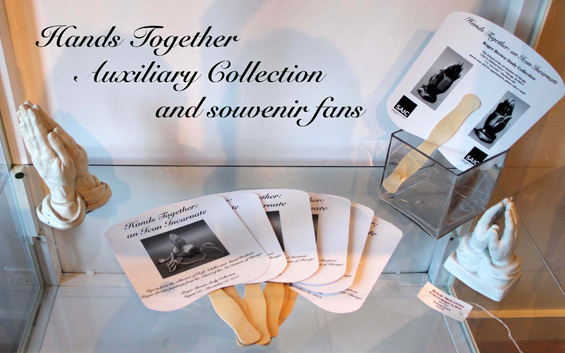
Hands Together is augmented by three Roger Brown paintings from SAIC’s collection each reflecting Brown’s engagement with religion, representation, popular culture, issues of scale, and the many dimensions of faith.
In Brown’s The Story of Creation he updates Giovanni de Paolo’s iconic composition to 1989, with Kenny Rogers as God. Brown riffs on the idea that a Western, Christian God has been envisioned as an older white man with gray/white hair and beard, and that popular entertainers are elevated to supreme status in our culture.
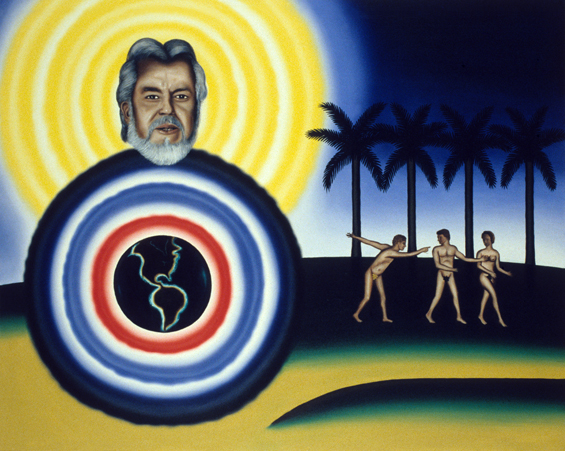 Roger Brown, The Story of Creation, 1989, oil on canvas, 48 x 60 in.
Roger Brown, The Story of Creation, 1989, oil on canvas, 48 x 60 in.
© The School of the Art Institute of Chicago and the Brown family.
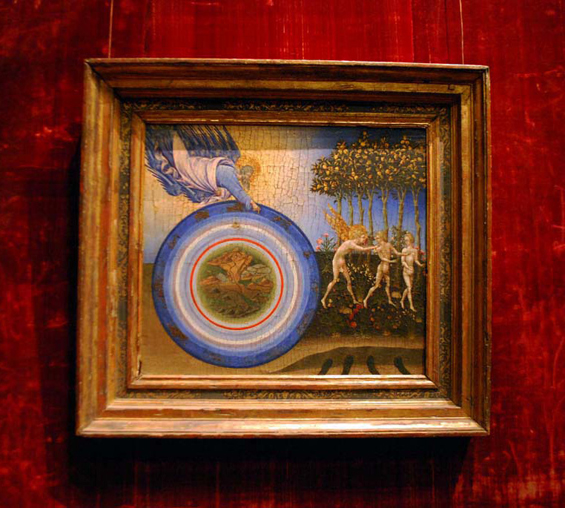 Giovanni di Paolo, The Creation of the World and the Expulsion from Paradise, 1445, Tempera and gold on wood, 18 1/4 x 20 1/2 in. (46.4 x 52.1 cm) Metropolitan Museum, New York, Robert Lehman Collection. Photo: Lisa Stone
Giovanni di Paolo, The Creation of the World and the Expulsion from Paradise, 1445, Tempera and gold on wood, 18 1/4 x 20 1/2 in. (46.4 x 52.1 cm) Metropolitan Museum, New York, Robert Lehman Collection. Photo: Lisa Stone
Veronica’s Landscape has long been a puzzler: why would Brown interpret Veronica’s veil as a landscape? (In the legend, Veronica wiped Christ’s face as he made his way to the crucifixion; his image was mystically transferred to the cloth, a ‘true icon.’) The portrait of Jesus is strikingly similar to an object Brown had in his La Conchita, California home, a slip-cast ceramic oval with what we come to recognize as the face of Jesus recessed in a concavity. This object––whose eyes appear to follow the moving observer–– may have been so oddly compelling that Brown just had to paint it.
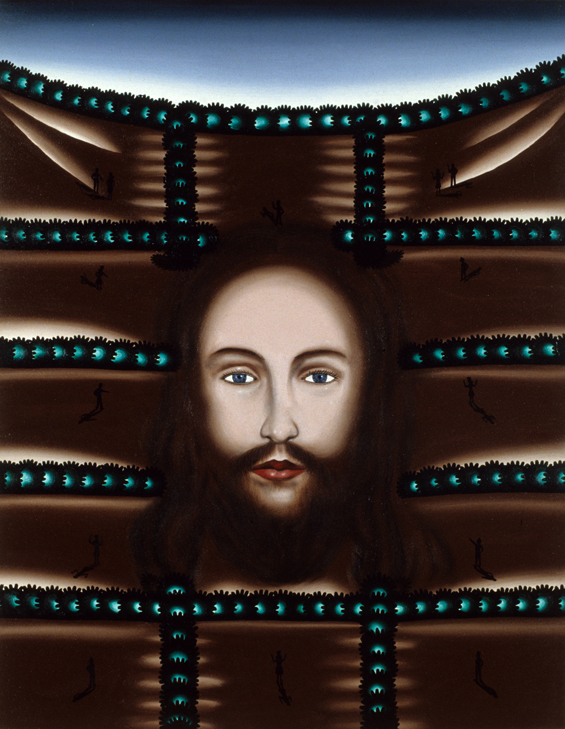 Roger Brown, Veronica’s Landscape, 1988, oil on canvas, 36 x 28 in.
Roger Brown, Veronica’s Landscape, 1988, oil on canvas, 36 x 28 in.
© The School of the Art Institute of Chicago and the Brown family.
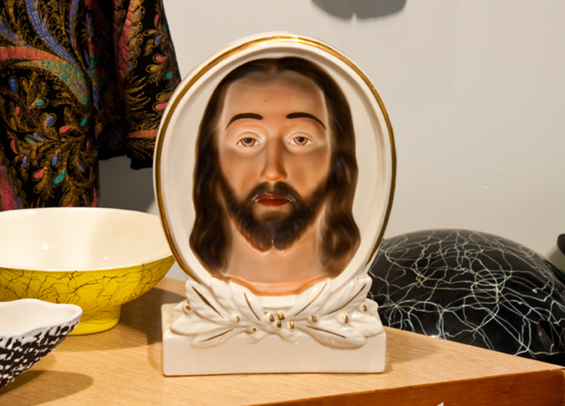 Artist unknown, concave portrait, “Jesus,” slip cast ceramic, glaze and paint. SAIC’s Roger Brown/La Conchita, CA Collection.
Artist unknown, concave portrait, “Jesus,” slip cast ceramic, glaze and paint. SAIC’s Roger Brown/La Conchita, CA Collection.
Virtual Still Life #16: 3 Saki Cups and Four Big Sur Communion Chalices With Oral Roberts Vision Of A Two Mile High Jesus, presents issues of scale in evangelizing. Oral Roberts indeed had a vision of a towering Jesus, which hit the newspapers and tabloids as a sensation. Brown created a very phallic interpretation of Roberts’ vision in 1984.
 Roger Brown, Oral Roberts Vision of a Two Mile High Jesus. 1984, oil on canvas, 72 x 48 inches.
Roger Brown, Oral Roberts Vision of a Two Mile High Jesus. 1984, oil on canvas, 72 x 48 inches.
© The School of the Art Institute of Chicago and the Brown family.
There is a praying hands tie in here: Oral Roberts did indeed commission a 60 foot tall bronze casting of praying hands for his City of Faith in Tulsa, OK.
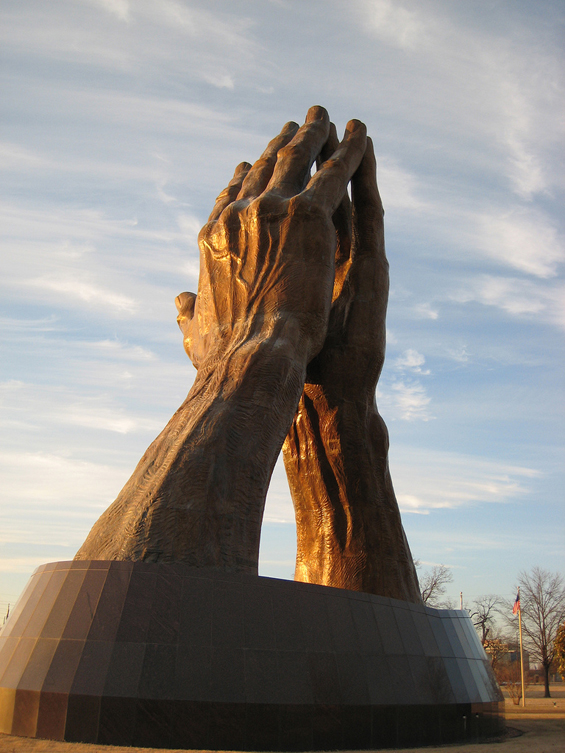 Oral Roberts’ Praying Hands
Oral Roberts’ Praying Hands
In 1995 Brown returned to the subject, placing the viewer, facing the vision of Jesus, point blank at two miles high in a sickly haze. Ordinary yet extraordinary ceremonial vessels ground the ground plane. Are we in heaven?
 Roger Brown, Virtual Still Life #16: 3 Saki Cups and Four Big Sur Communion Chalices With Oral Roberts Vision Of A Two Mile High Jesus, 1995, oil on canvas and mixed media, 29 ½ x 23 ½ x 9 in.
Roger Brown, Virtual Still Life #16: 3 Saki Cups and Four Big Sur Communion Chalices With Oral Roberts Vision Of A Two Mile High Jesus, 1995, oil on canvas and mixed media, 29 ½ x 23 ½ x 9 in.
© The School of the Art Institute of Chicago and the Brown family.
Hands Together inaugurates occasional exhibitions from faculty and staff collections, and the ongoing investigation of objects at the RBSC. We are open by appointment, please come have a look.
Rolf Achilles and Lisa Stone
There’s nothing like the return of sandhill cranes to the Midwest after a long winter.
Warm spring greetings from the Roger Brown Study Collection.
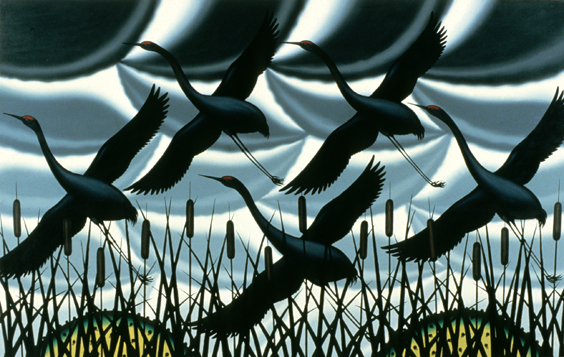
Roger Brown, Memory of Sandhill Cranes, 1981, oil on canvas, 60 x 96 inches
Managing the Roger Brown Estate continues to keep us on our toes. We’re thrilled to announce that the Ray Hughes Gallery in Sydney has enthusiastically embraced the work of Roger Brown. Working with Russell Bowman Art Advisory (on our side of the globe!), Ray and Evan Hughes will mount an exhibition of Brown’s work, which will open in March 2014, coinciding with the Sydney Biennale.

Ray and Evan Hughes
The Hughes Gallery website tells us, “In 1981 Ray Hughes collaborated with the legendary, Phyllis Kind Gallery on an exhibition titled ‘Chicago on Paper’ featuring the likes of Jim Nutt, Gladys Nilsson, Yoakum, Karl Wirsum, Roger Brown and Ed Pashke. Evan Hughes, when working for James Mayor in London, began looking at old catalogues from when Mayor had worked with the Chicago Imagists in the 1980s…The small world has come full circle with both Hugheses now actively engaging with the young Chicago scene…” Killer Crab (below) and other works will soon be on their way to Australia.
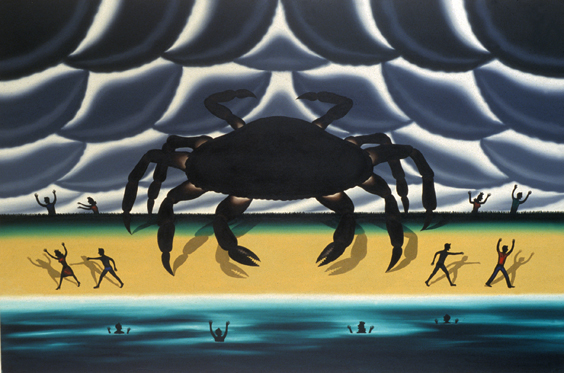
Roger Brown, Killer Crab, 1986, oil on canvas, 48 x 72 inches
It’s been a busy semester at the RBSC, with nearly 900 guests to date, and 33 classes, including classes that use the site weekly: Lisa Stone and Jim Zanzi’s Better Homes & Gardens: Vernacular Art Environments and Nick Lowe’s Collections Practicum. Students in Nick’s class took on a range of projects to advance aspects of the collection and archive. Jue Ma and Chiara Giulianotti worked on the documentation of Brown’s early student works, particularly his theatre paintings of 1967-68, going through hundreds of 35 mm slides, analyzing them in relation to images in sketchbooks, prints, and other graphic works, and to works by artists Brown admired (such as Magritte and O’Keeffe), to create an accurate record of this seminal period of his oeuvre.
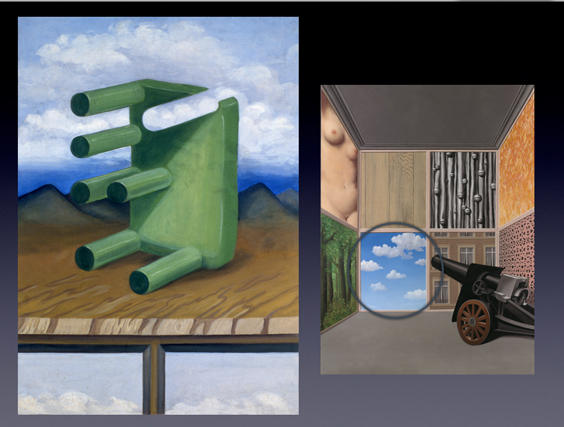
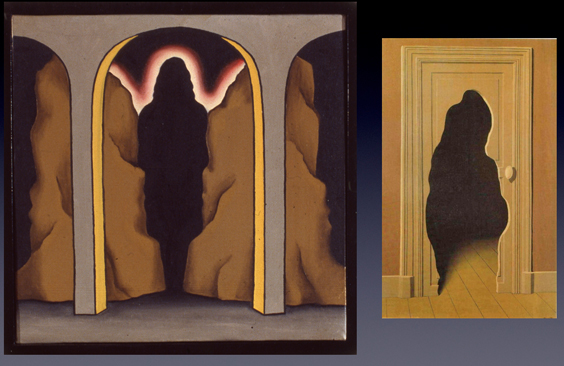
Comparison of works by Brown and Magritte.
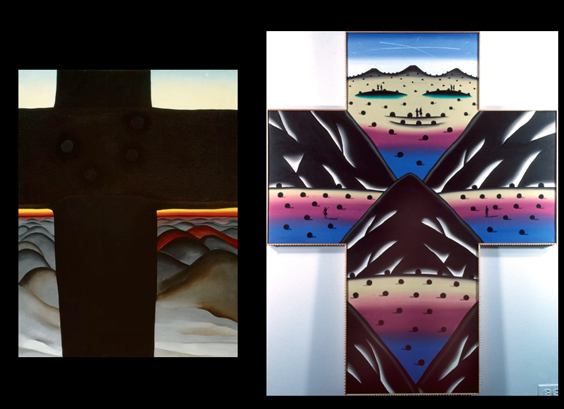
Caption: Comparison of works by O’Keeffe and Brown
Sarah Henninger began the project to catalog Brown’s collection of vinyl long playing record albums from his Chicago, Michigan, and California homes. Organizing over 250 albums into music genres was philosophically vexing so she organized them alphabetically and outlined the processes for cleaning, rehousing and photographing records, sleeves, and jackets, entering information into the database. We acquired equipment to create digital recordings from the record albums so we can eventually use Brown’s collection of music in ways too numerous to imagine at this time. Sarah’s project opened up a new dimension of exploration in our archive, and found interesting connections between his albums and his work.

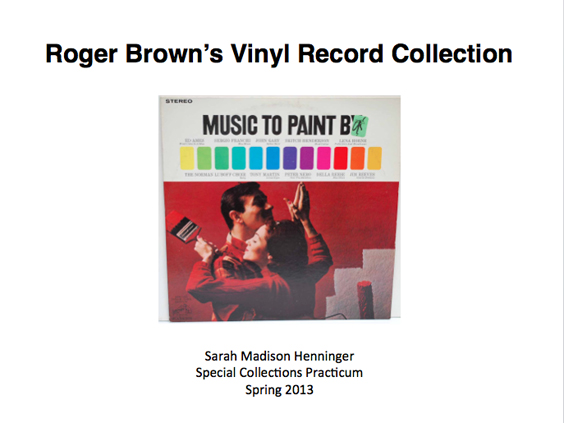
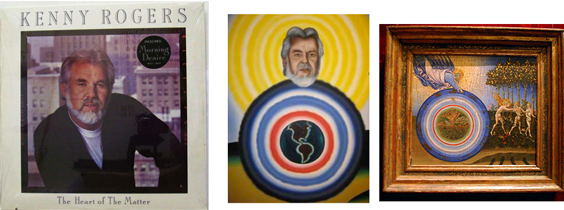
Center: Roger Brown’s Story of Creation (1989, oil on canvas, 72 x 48 in.) with Kenny Rogers as God (!) flanked by two sources of inspiration: Brown’s Kenny Rogers album cover on the left, and Giovanni di Paolo’s The Creation of the World and the Expulsion from Paradise (1445, tempera and gold on wood, 1/4 x 20 1/2 in., Metropolitan Museum of Art, photo: Lisa Stone).
Sarah Lensink and Tyler Blackwell worked with the Harold Allen Study Collection, examining many of Allen’s photographs, entering information about the prints, locations of images, and other documentation processes into the database. Their work advances the organization of this long dormant collection, so we can move closer to making this extraordinary material accessible. Working with Flaxman Library Digital Resources Librarian Chris Day, we’ve developed a website with hundreds of Harold Allen’s remarkable photographs. We’ll send an announcement when the site launches soon.
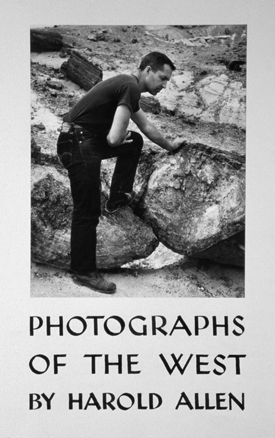
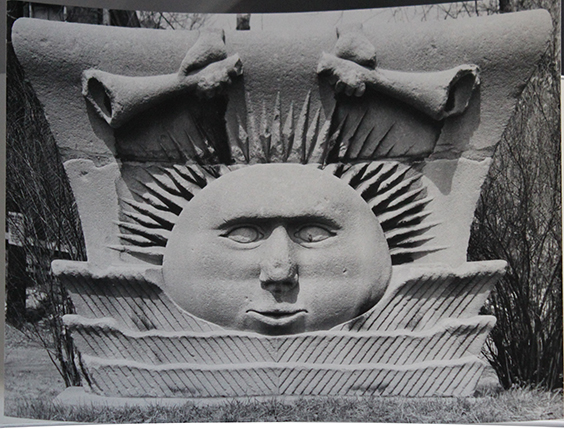
Harold Allen, Pilaster Capital (Sun Stone) from Mormon Temple, 1841-1845. Nauvoo Illinois, February 1953, gelatin silverprint, 1953
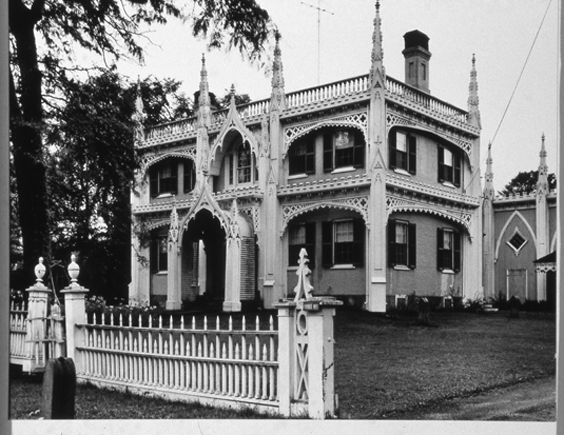
Harold Allen, Wedding Cake House, 1826. Kennebunk, Maine, gelatin silverprint, 1953.
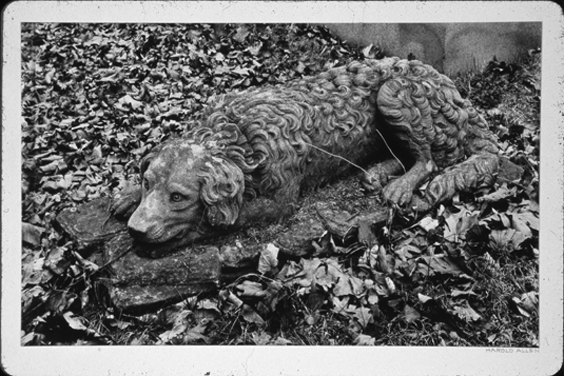
Harold Allen, Stone Dog on Dimick Monument, Chippiannock Cemetery, Rock Island, IL, April 15, 1956
Marie Zaro researched methods for elevating Brown’s 1967 Ford Mustang slightly off its tires, in a way that will still allow guests to sit in the bucket seats, breathe in the aroma of old leather, and get the feel of a late 1960s American classic. She also worked on design solutions for a new crate for Brown’s Pronghorn Diorama (1987), a work with a full scale taxidermied Pronghorn Antelope.

Mustang wheel and Zaro’s sketch for a crate for Pronghorn Diorama.
I attended a workshop of the Historic Artists’ Homes & Studios program of the National Trust for Historic Preservation in Santa Fe in early April. This year our meeting included a group of NTHP historic site directors and administrators. It was invigorating to meet with members from the other sites and National Trust staff, to share thoughts on our efforts to make our house museums perform fully, as art/historical/cultural treasures. It was especially exciting to have Estevan Rael-Galvez, Senior Vice President of Historic Sites and former historian of the State of New Mexico, guide us through New Mexico’s beguiling landscape with knowledge and passion for the land, its diverse inhabitants, and complex histories.
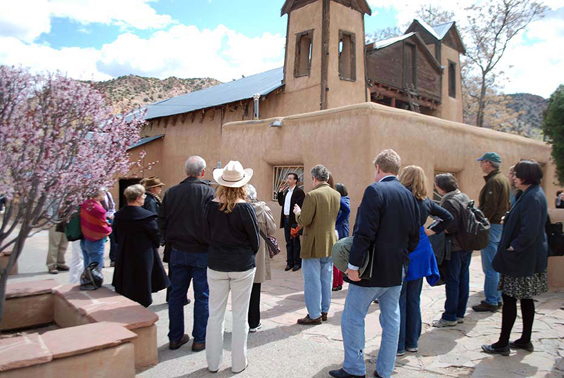
Estevan Rael-Galvez and the HAHS / NTHP group at Sanctuario de Chimayo
We visited Abiquiu and were introduced to the Native and Hispanic history of the village, and then toured the O’Keeffe home/studio/garden. We then had the rare opportunity to visit O’Keeffe’s home/studio/garden at Ghost Ranch. As members of the HAHS program, we all try to preserve and convey the relationships between homes and studios and creative practice. It’s always a thrill to visit sites where this relationship is instant and profound.

Photography is unfortunately strictly prohibited at both O’Keeffe sites.
Back at home in Chicago, I’m working with fellow house museum friends to create a website for At Home in Chicago, the family of 24 house museums in the Chicago area. With a generous grant from the Richard Driehaus Foundation we’re working with a truly talented team: Jon Satrom of studiothread and artist Lilli Carré.
The At Home in Chicago website will take some time to develop but for now we have a handy map with links to all the sites, so you can visit them all, online and in person.
Lisa Stone, May 2013
Posted in Blogging the Archive on Wednesday, April 17th, 2013
Written by Laura Bickford
I spent the Fall semester of 2012 reading, sorting, and organizing a collection of photocopied letters that Roger Brown wrote home to his parents from 1960-1976. These were formative years for Brown, documenting his decision to leave the South and become an artist, his first impressions of Chicago, art school, his now-famous peers, and his initial thoughts about collecting and arranging objects in his home.
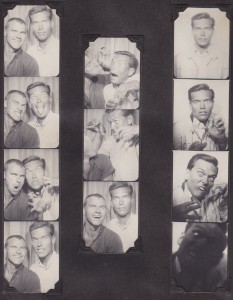
Not a lot is known about Brown’s life before he lived at 1926 N. Halsted and these letters offer some of the best clues of his developing worldview and evolving perspective on art-making as he found himself in a new, challenging, and inspiring city, both personally and artistically.
The original copies of these letters are in the collection of the Roger Brown Rock House Museum in Beulah, Alabama. Images in this blogpost are from the Rock House Museum collection.
During the period of 1960-1976, Brown left his parents’ home in Alabama for the first time to attend school at David Lipscomb College in Nashville, Tennessee. Sensing that the evangelical nature of the school was not conducive to the artistic life he envisioned, he spent some time taking art classes in Nashville and traveling through the South with a performer named Don. When he finally arrived in Chicago in 1960, staying first at a YMCA in Hyde Park, he wrote enthusiastic letters to his family detailing his new experiences, encounters, and impressions, both infectious and amusing. Particularly insightful, both to Brown as an artist and as a person, were his detailed descriptions of his lessons in art history and techniques. Before powering through his BFA in 1968 and his MFA in 1970, both at the School of the Art Institute of Chicago, he earned a certificate from the American Academy of Art and Design in commercial design. In one of the letters to his parents, he detailed an assignment involving repeatedly drawing straight lines for eight hours and his mastering of several typographies by free-hand. These early technical lessons, when considered with his job working at a decal company (and before that, counting steaks at his job as a maitre d’ at the Palmer House Hotel!), can be seen as clear milestones and important sources of influence in the later development of his exacting technique, both stylistically and philosophically. Additionally, the seriousness with which Brown relayed home his responses to his visits to the Art Institute, particularly to the work of Surrealist artists and pre-Raphaelite painters, and the detailed descriptions and diagrams he would include in his letters about his lessons on three-point perspective and his first appreciation of the diligence and creativity necessary to become an artist, were early evidence of his lifelong dedication to being a full-time, occupational artist who drew from the entire object landscape for inspiration.
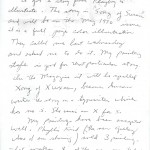
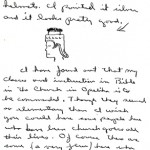
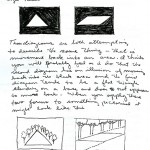
click to enlarge
After working at the Roger Brown Study Collection for three years and constantly being impressed by the continuity between Brown’s early observations and sketches, and his finished works and writing, reading these early letters home added a new appreciation to his foresight. His almost intuitive self-awareness of the gravity of events as they occurred, and the seeming recognition of the impact they would have on him later in life, is striking. In the letters, he would send accounts home to his parents about mundane events that we now know were pivotal in his career and the development of his artistic and philosophical sensibility. This ability to recognize important moments in his life as they happened to him lends a deeper layer of meaning for me, for the RBSC and the archival collections housed within it. The sorts of documents he saved, now in the archive, has always been surprising to me; even more shocking is when one of these seemingly random letters or scraps of paper reveals the answer to a question about one of his works of art or an object in the collection that had plagued us. Brown’s ability to see everything through a big-picture lens is evident in his works that are simultaneously deeply personal but enlighteningly universal. His awareness of the long-term importance to the School and future students of his house and collection at 1926, is an aspect of the Study Collection that is perhaps one of the most powerful lessons I will take with me. By keeping yourself constantly open to the possibility of having a life-changing experience at any moment allows for just such experiences to happen. Getting as close as possible to what moves you, whether objects, places, people, or thoughts, and allowing those things to change you without an awareness of in what way or for what purpose, is an important aspect of a life worth living.
It felt so fitting to end my time at the SAIC, the Study Collection, and perhaps Chicago, reading about Brown’s beginnings at the school, 1926, and this city, which he grew to love so much.
You can access a map showing all of Brown’s Chicago addresses during this time here. The map offers insight into the neighborhoods Brown was living in and reacting to as moved around the city.
Here are two timelines, one indicating the addresses he lived at in Chicago during this
time, and the other indicating the chronology of his education.
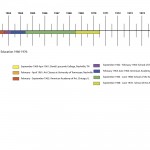
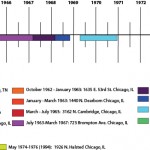
Click to enlarge
Posted in ALL THE NEWS on Tuesday, December 11th, 2012
Greetings. The RBSC is in its fifteenth year of serving SAIC as a house museum encompassing the intimate nature of “home,” among many other things. 2012 is also the fifteenth anniversary of Brown’s passing from this world into the next, and from full time artist in his lifetime, to full time teacher posthumously, through his many gifts to SAIC. We remember Roger with gratitude––his gifts are alive as ever.
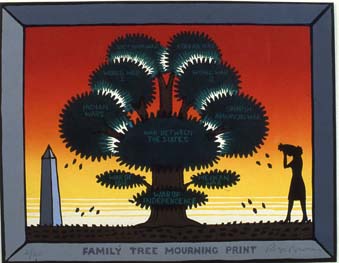
Roger Brown, Family Tree Mourning Print, 1987, color relief print, 10 3/4 x 13 in.
Here’s what we’ve been up to:
Hosting guests, lots of guests. By the numbers:
2400+ guests (up from 2011’s 1639), 89 SAIC classes (64 this semester), more independent researchers, and more half or full semester class projects.
Gillion Carrara’s spring semester Collections Practicum class worked on intriguing projects at 1926. One team attacked the “Top Drawer” project, documenting and rehousing Brown’s early/student graphic work, analyzing the relationships between his paintings and sketchbooks from the mid 1960s.
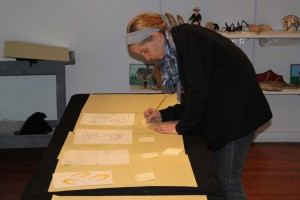
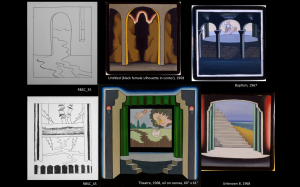
“Top Drawer” project: student at work and analysis of Brown’s theatre drawings and paintings
Emily Platt chose to examine Brown’s Pronghorn Diorama , which had been crated since 2004. Concerned about its condition we examined the pronghorn with Ruth Norton, conservator at the Field Museum of Natural History. Norton provided an in-depth description of its condition (pretty good!) and later gave Platt and RBSC staff a behind-the-scenes tour of storage containers for taxidermy and objects with organic components at the Field Museum.
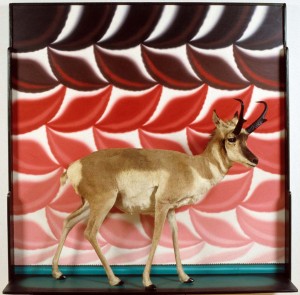
Roger Brown, Pronghorn Diorama, 1987, oil on canvas,
taxidermied pronghorn antelope, 74 x 72 x 21 inches
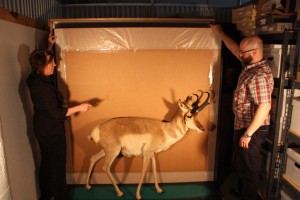
Lisa Stone and Nick Lowe unpacking “Pronghorn Diorama
Other class and research use of the RBSC included:
– Nick Lowe’s Unpacking Roger Brown course (fall 2012) used 1926 as home base, radiating from here into major private collections, museums, and galleries, in their intensive examination of specific paintings, through which they explore radiating themes, concepts, ideas, and interrelationships between and among Brown’s works and the world.
– Stone and Zanzi’s Better Homes & Gardens: Vernacular Art Environments met at 1926 each Friday, spring semester.
– Clemenstein Love’s Intro to Interior Architecture class used the first floor of 1926 for two major design projects, creating models and design solutions presenting an array of intriguing possibilities. A few may be realized but all become part of the creative record of the site, not unlike the 1922 Tribune Tower competition.
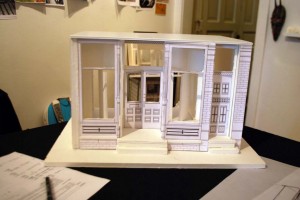
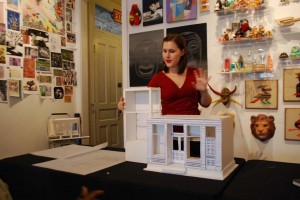
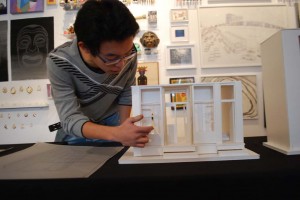
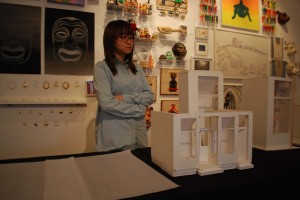 11/6/12: Election day and model critique: projects by Hequin, Michal, Yulun, and Yushi.
11/6/12: Election day and model critique: projects by Hequin, Michal, Yulun, and Yushi.
Thankfully, the project motivated the long overdue removal of the clumsy wing walls, replaced by temporary black drapes––a touch of class!
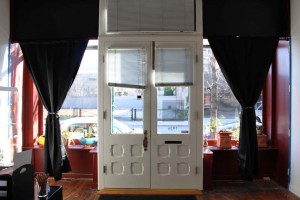
Storefront from within, sans dreadful “wing walls”
Patricia Rieger’s Diminutive Object class installed sculptures throughout the collection for their mid-term critiques. Juxtaposing works in the collection created a challenging context for critiquing the works, stretching the collection temporarily, beyond Roger Brown’s realm.
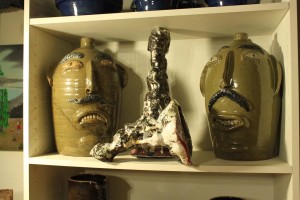
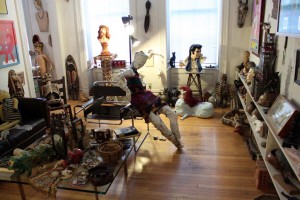
Diminutive Object critique
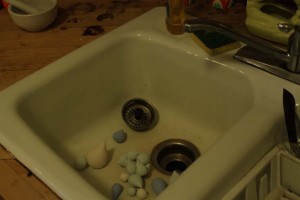
Diminutive Object critique
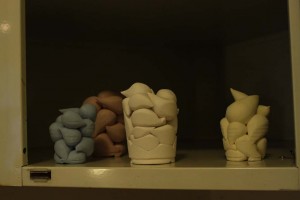
Diminutive Object critique
A visit from Lela Hersch’s Arts Administration Arts Consulting class, in which seasoned consultant Hersch and the class explored and critiqued most aspects of RBSC collections administration, resulted in many ideas for improvement and future projects.
Under the inspired direction of Leslie Buchbinder, Pentimenti Productions continued to use the RBSC archive to support the inaugural documentary film Hairy Who and the Chicago Imagists! PP has graciously covered expenses to migrate RBSC archival media into digital formats and share the wealth of their in-depth research. We look forward to celebrating the release of the film in 2013.
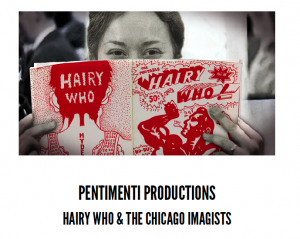 Other scholarly digging in the archive included:
Other scholarly digging in the archive included:
– University of Michigan art history student Franny Mendes Levetin, summer internship, organized documentation of Barbara Rossi’s career from the Phyllis Kind Gallery Archive.
– Katie Campbell, MA candidate at Christies Education, New York, conducted extensive research for her thesis Paintings and the Proscenium: Roger Brown and the Theater.
– Northwestern University sociology grad student Gemma Mangione researched the ways artists defined as “regional” are constrained and marginalized, but perhaps also benefited in some ways by that designation.
Collections
In September we deinstalled 36 beloved Yoakum drawings, to rest for at least one year. The Yoakum room is the only place with many works by a single artist in the RBSC and it feels quite bare. We now have the “Yoakum Lounge” where guests can peruse slide shows of Brown’s Yoakum drawings, the Art Institute of Chicago’s online collection of over 220 works, and a video interview of AIC curator Mark Pascale with Roger, in the room, in 1995. It’s comforting to hear Roger and Mark’s voices emanating from the room while the drawings are at rest.
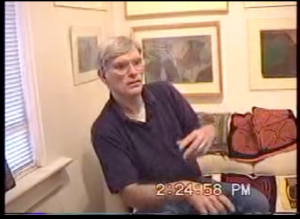
Video still, Roger Brown 1995 interview in the Yoakum Room
Good Golly Miss Molly! An accomplished object imitator, staff member Molly Hewitt created captivating painted ceramic versions of the lineup of mostly sugary products on the top shelf of the kitchen cabinet; she arranged them on the shelf beneath. In this house full of objects there’s simply no telling which ones will inspire action.
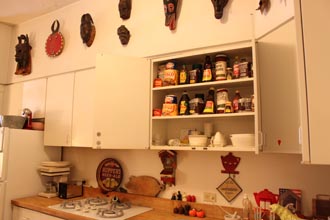
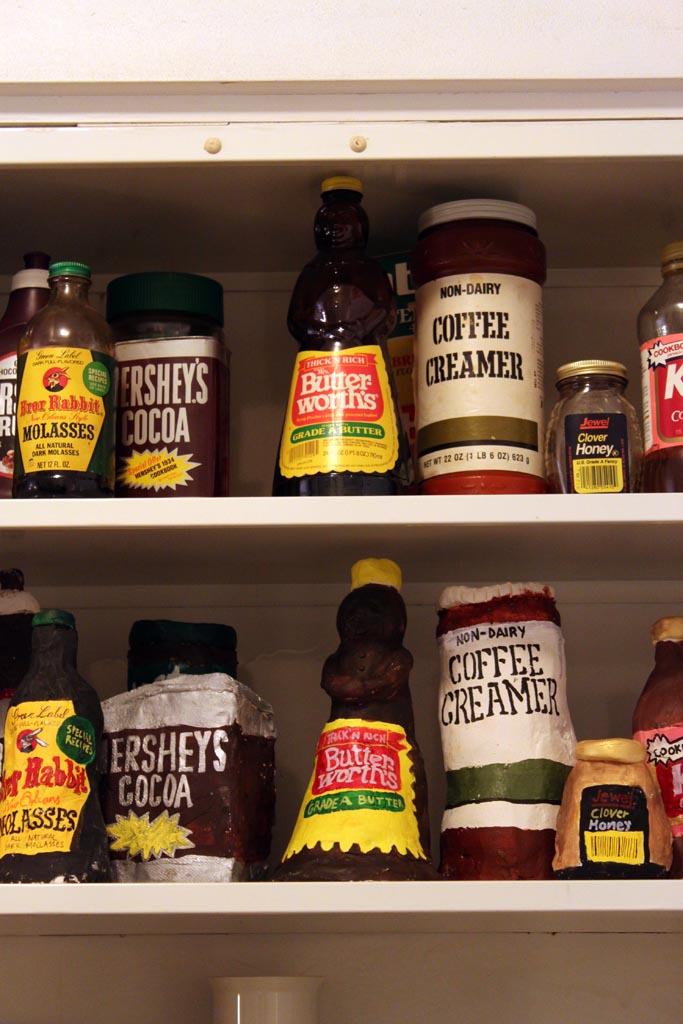
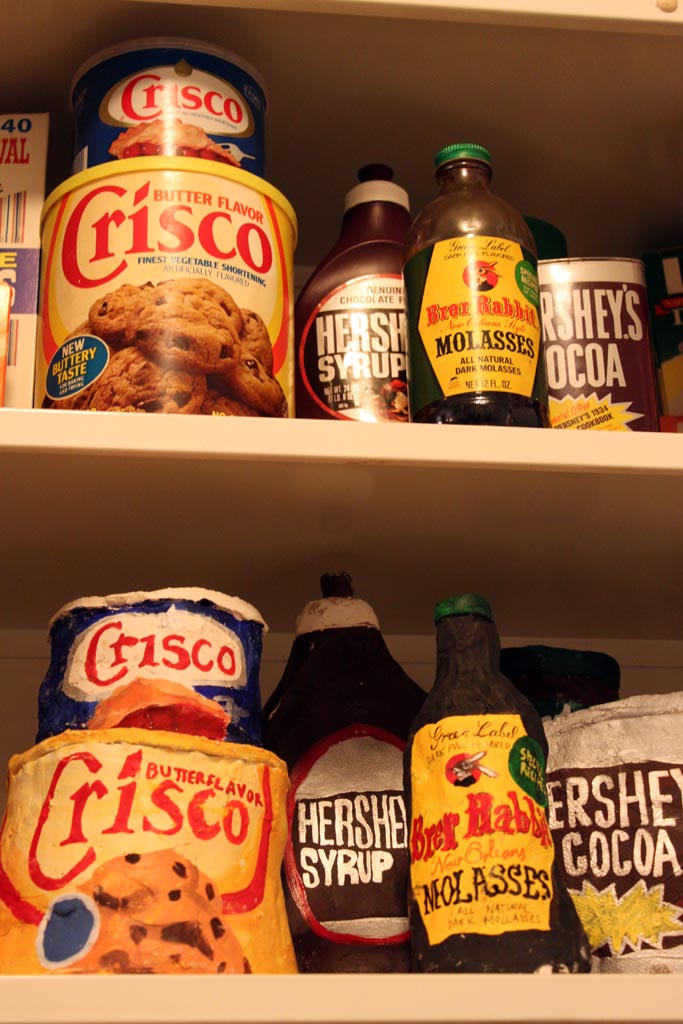
Exhibitions
Staff spent much of the summer preparing paintings for exhibition: 29 works for Roger Brown: This Boy’s Own Story and 23 works for Roger Brown: Major Paintings, and one for Afterimage.
Curated by Arts Admin/Art History student Kate Pollasch. Roger Brown: This Boy’s Own Story explored sexuality in many of its guises throughout Brown’s career, including erotic landscapes, sex in the city, love, longing, loss, HIV/AIDS, and pure joy, on view at SAIC’s Sullivan Galleries, from August 24 to November 10. The project illustrates possibilities for creative professional work graduate students can achieve at SAIC. Kate’s research continues in her masters thesis, contextualizing Roger Brown’s work addressing sexuality into the larger cultural, theoretical, and art historical narrative of 1970s sexual liberation and 1980s and 90s HIV/AIDS and culture wars in America. Below are a few views. Click here for a pdf virtual tour.
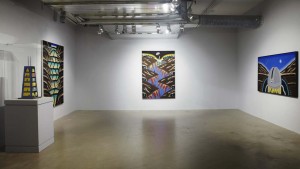
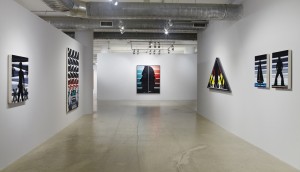
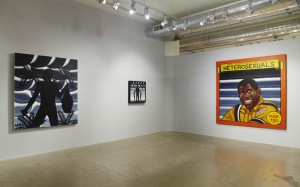
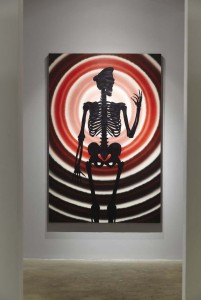 “Roger Brown: This Boy’s Own Story” exhibition installation views courtesy of the School of the Art Institute of Chicago’s Sullivan Galleries; photos: Tony Favarula.
“Roger Brown: This Boy’s Own Story” exhibition installation views courtesy of the School of the Art Institute of Chicago’s Sullivan Galleries; photos: Tony Favarula.
A pdf virtual stroll through the exhibition can be found here. We extend special thanks to Kate for a wonderful, insightful project and labor of love, and to Executive Director of Exhibitions and Events Mary Jane Jacob, and Sullivan Galleries staff Kate Zeller, Trevor Martin, Todd Cashbaugh, Christina Coscio, for their unconditional support of the exhibition and their assistance in every aspect of this ground-breaking exhibition.
The Roger Brown: Major Paintings dual exhibitions at Russell Bowman Art Advisory and Zolla Lieberman Gallery presented an array of Brown’s work spanning much of his career, from early, c.1968 works, to paintings from the last chapter of his life in California, and many in between.
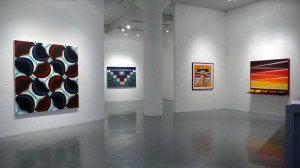
Roger Brown: Major Paintings at Zolla Lieberman Gallery
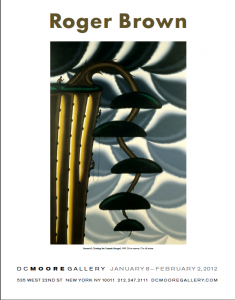
A solo exhibition of Brown’s work will be on view at D.C. Moore Gallery, New York, January 8 – February 2, 2013. Robert Cozzolino will give a lecture there on January 26.
The exhibition Afterimage at the RBSC enlivened the RBSC from September 14 – November 18. A satellite component of Afterimage at the DePaul Art Museum curated by Dahlia Tullett Gross and Thea Liberty Nichols Afterimage at the RBSC featured micro-exhibits by Carl Baratta, Edra Soto, and Onsmith. Packed installations combining their own works, works by friends, source materials, and collections of sundry objects that they live with in dense intimacy, provided a perfect backdrop for orienting (and disorienting!) our guests.
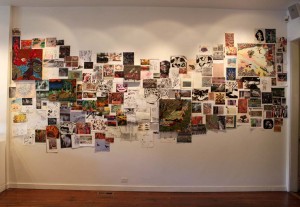
Carl Baratta installation

Edra Soto installation
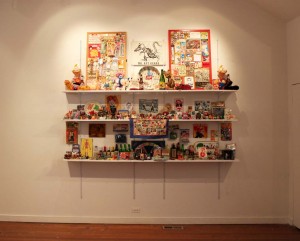
Onsmith installation
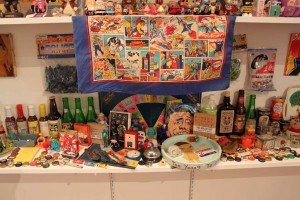
Onsmith installation detail
Sprucing up the storefront: To maintain a mysterious RBSC storefront identity to the street, and celebrate the artists’ own “museums” we installed perforated window banners of slides taken by Brown in 1972, of Burnette G. Pletan’s Artists Museum, somewhere in South Dakota. Pletan’s title was Brown’s touchstone, and he wrote that he wanted to call the RBSC Artists’ Museum of Chicago, because …the things in it are of universal appeal to all artists and people with a sense for the spiritual and mystical nature that material things can evoke.
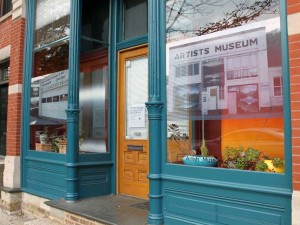
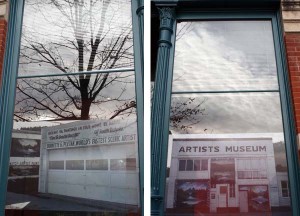
Stellar Staff ProjectsIt’s almost not possible to believe how deeply and creatively Nick Lowe delved into the realm of Roger Brown’s life and works, both realized and unrealized, during his one year sabbatical. Much of it can be seen in his blogpost and sabbatical blog.
When not hosting the near continuous flow of class visits, James Connolly, Ariel Fang, Laura Bickford, Molly Hewitt, and Danyu Xu all worked on various and sundry collections and archive organization projects.
The garden: In 1994 or thereabouts Roger transformed a weedy backyard with brick garage into a charming garden conjoining vernacular and high-style elements with conifer plants, thus distilling ideas and beliefs fundamental to his creative life. Last summer we brought in tree care experts to advise on the rocket juniper, which was looking poorly. Shortly after charting a course of treatment, a wild storm struck, repositioning it into a graceful, Martha Graham-like bow. It’s now decked out for the holidays…
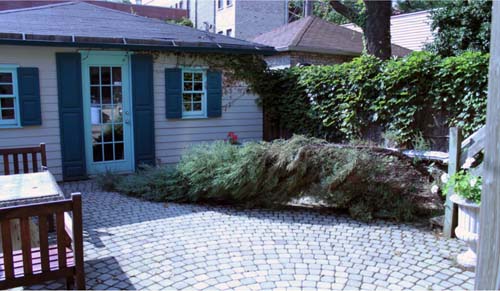
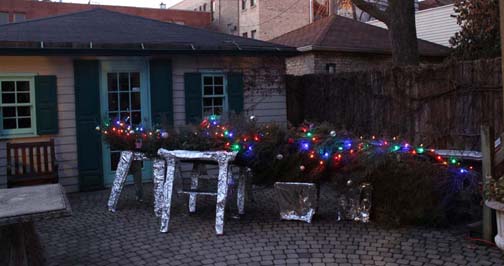
Friends and comrades: Linda Cathcart and friends at Casa Dolores (Santa Barbara) held a Roger Brown Garden Dedication and Tea Party. Brown was close friends with Casa Dolores’ founder and director Linda Cathcart. Nick Lowe worked with Linda and her staff, creating a garden in Brown’s honor, with ceramics on loan from SAIC’s Roger Brown La Conchita, CA collection. We thank Casa Dolores friends for honoring Brown and keeping his legacy alive in southern California.
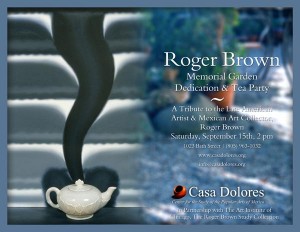
The At Home in Chicago consortium now has 23 affiliates. An enchanted summer reception was held at the Paul Schweikher House, where artist Martyl (designer of the Doomsday Clock, among many other things) lead us through the outstanding home and studio where she has worked for over 60 years. The RBSC hosted the group in September, where we fine-tuned ideas for the consortium website, which we hope to launch in 2013.
The RBSC has been an affiliate of the National Trust for Historic Preservation’s Historic Artists Homes and Studios program since 2000. In May the Judd Foundation invited Lisa to participate in a Visitor’s Experience Think Tank. She joined 24 house museum colleagues scholars of the genre at a day long discussion, held at the Renee and Chaim Gross Foundation, the wondrous home/studio/collection of sculptor Chaim Gross, his wife Renee, and their daughter Mimi Gross. Mimi shared warm memories her years in Chicago and visits with Roger at his 1926 collection, noting the shared sensibilities among artists’ collections.
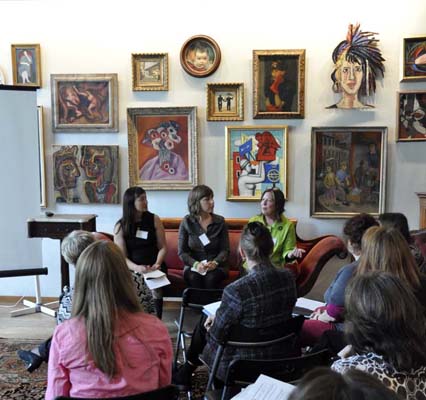
Judd Foundation Visitor’s Experience Think Tank
The Brown family Greg and Benedicte Brown spent a few days in New Buffalo in early August. We joined them for a special dinner, celebrating with a bottle Roger had saved for just such an occasion, a 1971 Chateau Mouton Rothschild (which had unfortunately gone a bit vinegarey!). Roger and Greg’s cousin Trudy Ballinger and her husband Roy traveled to Chicago in October to see all three Roger Brown exhibitions. Beloved Aunt Iva (who passed away on November 20, 2011) had faithfully attended nearly every exhibition of Roger’s in the Chicago area. Trudy has taken over for Iva, and plans to keep up the tradition.
We concluded the semester with a fireside chat/command-concept performance with the legendary Jon Langford and Sally Timms, who shared thoughts on being creative people while sidestepping the mainframe minefield, remaining true to themselves, for their entire careers. Excellent wisdom for Peter Exley’s freshman Contemporary Practice students to hear, and all in attendance were charmed. You can watch their performance HERE
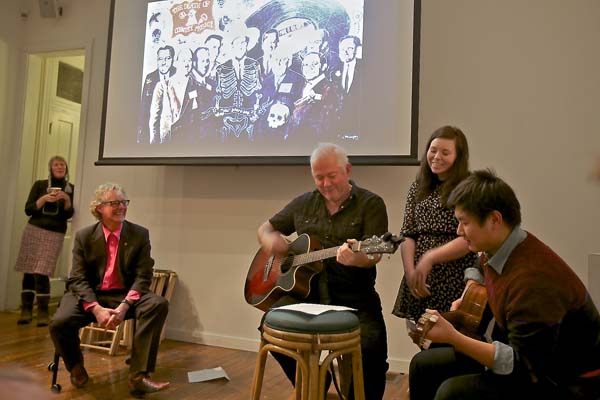
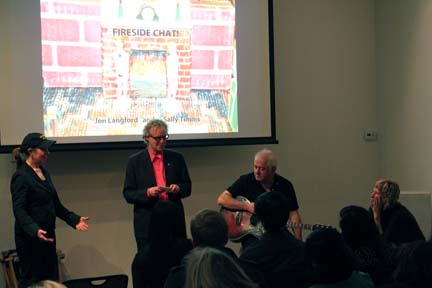
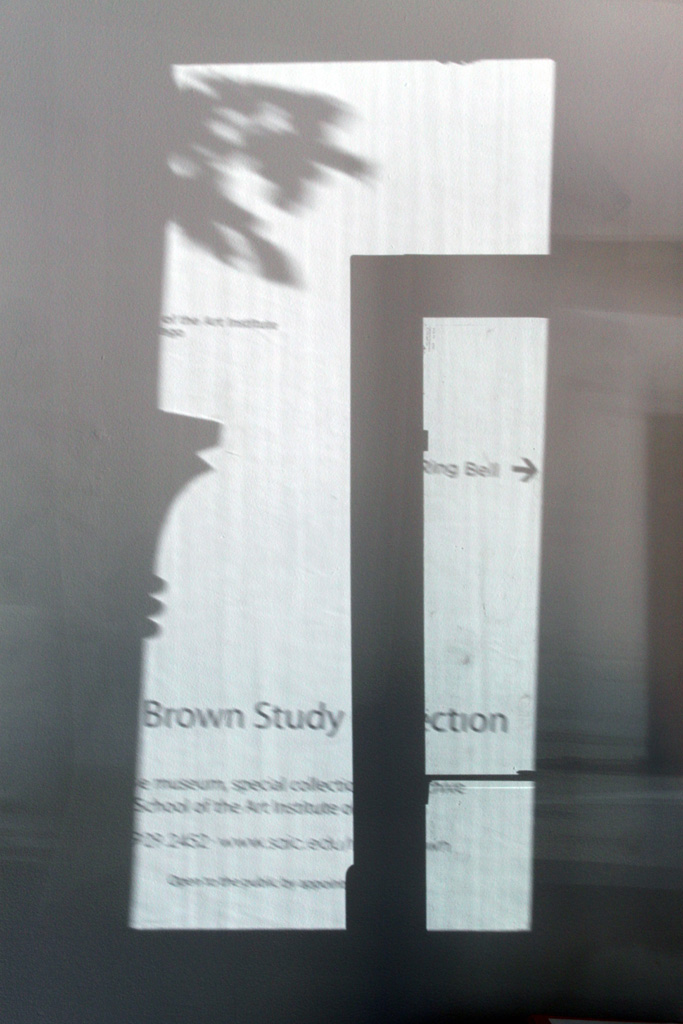
Posted in ALL THE NEWS on Monday, October 1st, 2012
On the occasion of the dual exhibition, Roger Brown: Major Paintings (September 7 – October 27) at Russell Bowman Art Advisory and Zolla Lieberman Gallery we were thrilled to host the lecture Roger Brown is Deadly Serious! by Dr. Robert Cozzolino, at Zolla Lieberman Gallery on Wednesday, September 12. Bob’s lecture is now online and can be seen here.
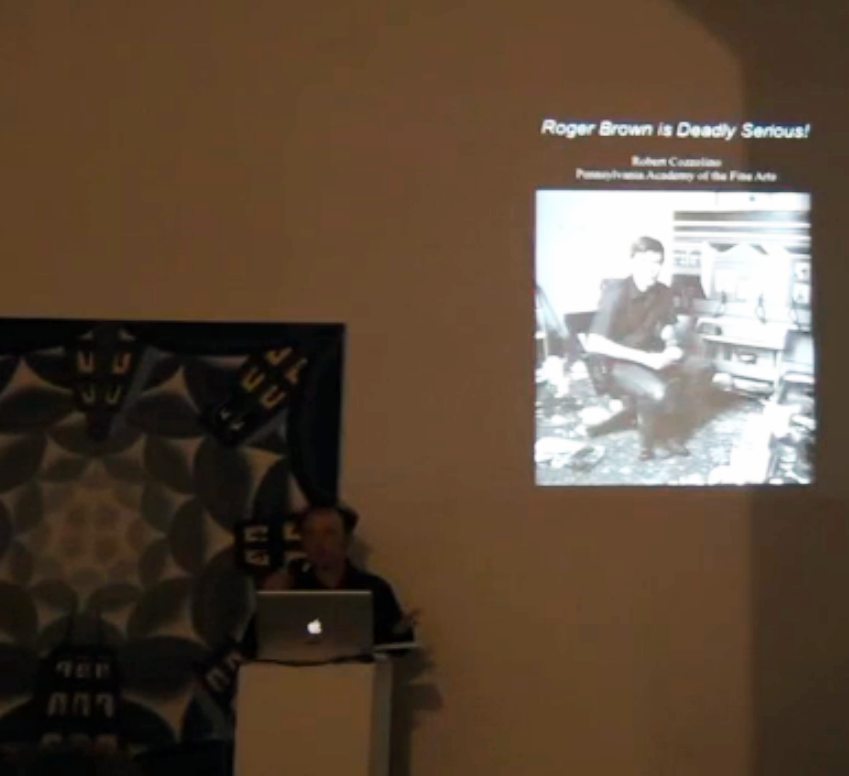
The gallery was packed with fans of both Roger Brown and Bob Cozzolino, and Bob did not disappoint. Far from it, his lecture was packed with insightful thoughts on art in Chicago and the relentlessly bold positions Brown took, through his work, on the art world, politics, and other issues addressed with deadly seriousness.
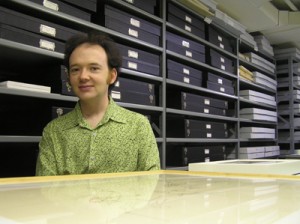
Dr. Cozzolino is Senior Curator and Curator of Modern Art at the Pennsylvania Academy of Fine Arts, Philadelphia. He has organized many outstanding exhibitions including Art in Chicago: Resisting Regionalism, Transforming Modernism (2006) and The Female Gaze: Women Artists Making Their World (opening November 2012). A Chicago native and inspired scholar of Chicago art, Dr. Cozzolino has been called “the curator of the dispossessed” because of his attention to the underdog.
Don’t miss the exhibition Roger Brown: Major Paintings on view through October 27 at both Russell Bowman Art Advisory, 311 West Superior Street, and Zolla Lieberman Gallery, 325 West Huron.
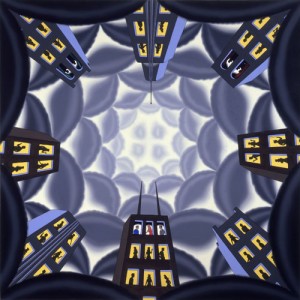
Roger Brown, Rising Above It All, 1978, oil on canvas, 72 x 72 inches
The Spartan Trailer is reunited with part of its garden, and much more.
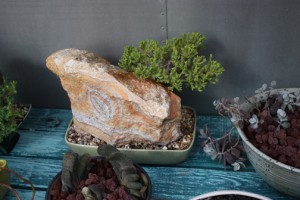
A detail of the Spartan Royal Mansion Garden arrangement recently reconstructed at the Museum of Jurassic Technology, Culver City CA
In the course of the previous two months the long talked about Spartan Garden reconstruction has been accomplished. Having just returned from the second excursion to the West, this time via a northerly route (Wisconsin, Minnesota North Dakota, Montana, the Idaho pan handle, Washington, Oregon and California). Still very much on the trail of Roger Brown, via Seaside OR, where I visited Dennis Adrian, much as Brown had done in the 1980’s and then traveling onwards south to San Francisco CA to see Phyllis Kind, finally arriving at Culver City on April first. For one month I took residence in the Spartan Royal Mansion at The Museum of Jurassic Technology to complete the models I had begun in the Fall (details on this project is below) and to oversee the re-assembly installation of part of Roger Browns garden alongside the trailer itself. In addition I also supervised the loan of items from the La Conchita Garden collection to Casa Dolores, Linda Cathcart’s recently established Museum of Mexican Folk Craft in Santa Barbara where they will form part of a display in the garden at Casa Dolores a commemoration of Roger Brown’s life in California.
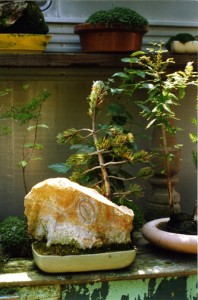
A photograph taken by Roger Brown of one of the plant arrangements alongside the Spartan Royal Mansion Trailer as it appeared in the mid 1990’s
The Spartan Garden, at the Museum of Jurassic Technology, Culver City, CA
The idea for reconstructing sections of the La Conchita Garden grew in part from work completed in preparation for the exhibition, Roger Brown Calif. USA (Hyde Park Art Center, June – Oct, 2010). Since 2008 I have worked with RBSC staff and with students through class projects and with the aid of much additional volunteer help, to assess and re-organize all the objects that were located in the La Conchita garden. And while this process is not yet completed the storage locations of all materials have now been confirmed and all items can be identified via the database by a designated location name that indicates where things once were in the La Conchita garden. In this process it became clear that Roger had organized the garden materials into distinct groups, choosing complementary plants and contrasting shapes with very careful consideration of placing and levels too. These details pointed to certain structural foci and this included the Spartan Royal Mansion trailer.
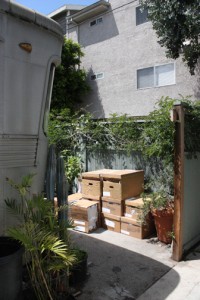 The 35 boxed objects are again reunited with the spartan after 10 years apart, seen here resting on the day of their delivery .
The 35 boxed objects are again reunited with the spartan after 10 years apart, seen here resting on the day of their delivery .
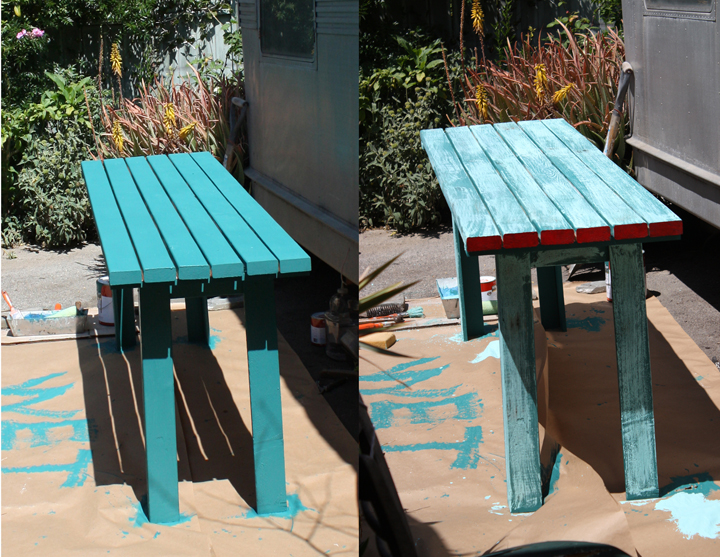
A table was constructed to resemble the one seen in photographs of La Conchita here at The Museum Of Jurassic Technology the new table can be seen getting its final faux-distressed treatment.
 The center image shows Nick holding one of the smallest objects in the collection, a miniature porcelain Greek style vase. The image on the left shows this vase at La Conchita in the late 1990’s and the image on the right as it now appears in the restored arrangement after planting.
The center image shows Nick holding one of the smallest objects in the collection, a miniature porcelain Greek style vase. The image on the left shows this vase at La Conchita in the late 1990’s and the image on the right as it now appears in the restored arrangement after planting.
Through the careful close inspection of photographs taken at La Conchita almost all the former locations and uses of each item from the garden has been established. Being able to understand how Brown had planted each pot, and then how he had arranged and grouped these items has been key in moving the garden reconstruction forward. Following the formal gifting of the Spartan Trailer to the long term care of the Museum of Jurassic Technology in November 2010, (the trailer had been on loan to the Museum by SAIC since 1998) the logic for making an additional gift of related garden items became extremely compelling. Through additional close research an initial set of 55 objects (from a total of over 500) were identified and from these a final list of 34 objects was agreed upon and then shipped to the Museum of Jurassic Technology in Culver City.
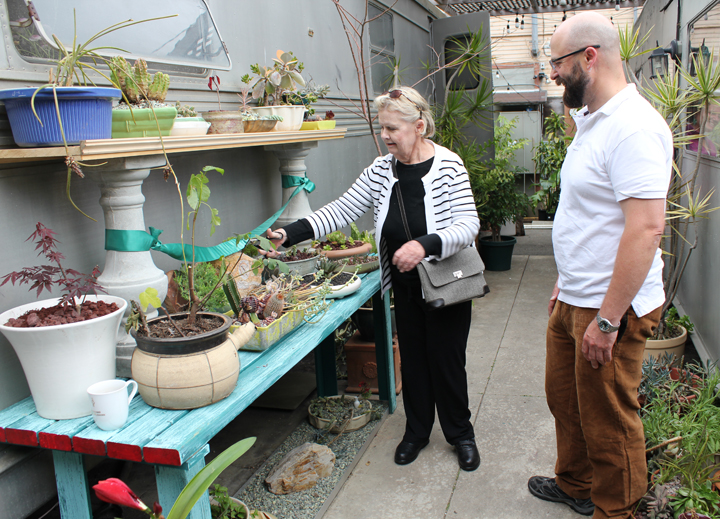 At the opening garden party Linda Cathcart was invited to cut the ribbon.
At the opening garden party Linda Cathcart was invited to cut the ribbon.
http://www.youtube.com/watch?v=7W1so30wkdM&
The Roger Brown Garden at Casa Dolores, Santa Barbara, CA
Casa Dolores, Center for the Study of the Popular Arts of Mexico, was founded by Linda Cathcart as a permanent home for her collection of hand crafted objects from Mexico. Having begun her career at the Whitney Linda went on to make a significant impact at the Albright-Knox Gallery in Buffalo NY where she gave many artists the first museum show of their career, Ed Ruscha, Bruce Nauman and Robert Longo, to name but a few. Meeting Roger Brown in the mid 1980’s when she was Curator at Houston’s Contemporary Arts Museum in Texas. Linda went on to open her own commercial gallery in Santa Monica in the late 1980’s and through it she became known for her support of artists such as Alice Neel, Jim Shaw, and Cindy Sherman. Linda has pursued her passion for Mexican craft objects since she was a child. A passion initially kindled while on family trips to Mexico and that continues to the present day as a collection of over 6000 remarkable items. The establishment of Casa Dolores with its changing and focused exhibitions is beginning to signify the collection as an important source of detail for this kind of material. When becoming better acquainted with Roger Brown in the late 1980’s they both recognized in each other a passion for collecting vernacular objects. Their friendship grew strong via a series of excursions and exchanges that were concerned with seeking out traditional ceramics from Mexico and the mid century North American and Californian ceramics upon which Mexican aesthetics have had such a great influence. The exchange of ideas extended into the arrangements they each made of their collections in their homes and gardens. At Casa Dolores today, Linda readily acknowledges the distinct influence that Roger Brown’s approach to collecting and arranging has bought to her thinking when making her own garden arrangements.
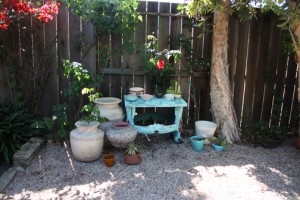
An initial installation of the ceramics on loan to Casa Dolores. The items will be planted and arranged in a manner that evokes the spirit of Roger Brown’s arrangement of these objects as they once appeared in his garden at La Conchita in the mid 1990’s.
In complete recognition of her friendship with Roger and of their creative exchanges over collecting and garden making, Linda has established an area of the garden at Casa Dolores as a garden for Roger Brown. Some years ago she planted two red tea roses intending that they should form an arch as a tribute to Roger who had planted roses of this kind at La Conchita. Linda has talked about how Roger in his use of this particular rose and its combination with cacti, wanted to reflect the decorative horticulture common in the gardens of all the California Missions. Brown visited many of the missions and demonstrated his enthusiasm and love for them by borrowing for his home many of the physical aspects he saw there. The structure and organization of the La Conchita house with its clerestory buildings are alone significant for the way they resemble ecclesiastical buildings but it is in the earth pink color that he painted the exterior of his house in La Conchita that we see the most direct reference to the California missions. Brown insisted the pink should be the exact same tone as that on the walls of the cemetery at La Purisma in Lompoc. The precision and clarity in Brown’s home and garden making at La Conchita is something that had struck Linda as significant to remembering his life in California. In our recent conversations Linda and I had talked about her desire to honor Roger’s La Conchita garden in her own at Casa Dolores by bringing together pots and re-creating plantings for them that echo Roger’s approaches. And it is on this basis that thirteen objects from the La Conchita North garden, the street side of the house, could be offered on loan to Casa Dolores. I was able to personally deliver these objects to Casa Dolores in April and also to spend time with Linda and her staff to advise on their installation and positioning in the garden.
Trailer living – Models and Video’s in the Spartan Royal Mansion
Another main function of my residency at the Museum of Jurassic Technology was to build and install a series of models inside the Spartan Trailer itself. The trailer is replete with niches and closets, and a key aspect of trailer living and trailer design is their economy of space, Spartan trailer design is known in particular for its attention to detail and utility. Discussions with the team at the Museum about installing models in the trailer had begun in the Fall of 2010, and by doing this to bring aspects of Roger Brown’s La Conchita life back to the trailer. Additionally, the Museum of Jurassic Technology has a longstanding interest in mid century trailer design and aside from the Royal Mansion, (Roger Brown’s trailer, formerly moored at La Conchita) David Wilson, the Museum’s creative director also owns a Spartanette, a trailer that predates the Royal Mansion by 10 years or so. Interest in trailer life is also expressed through one of the museum exhibits, “The Garden of Eden on Wheels – Selected Collections from Los Angeles Area Mobile Home and Trailer Parks”. Key to this exhibit are a series dioramas in miniature that show scenes with mobile homes in California settings alongside displays of ceramics and domestic vernacular objects from actual trailer inhabitants in the LA area. The exhibit also features narratives about homeliness and establishes the emotional grounds for a sense of belonging in transience.
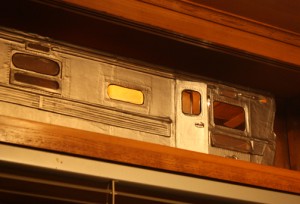
The ‘outside’ spartan model installed in the trailer at The Museum Of Jurassic Technology, Culver City CA
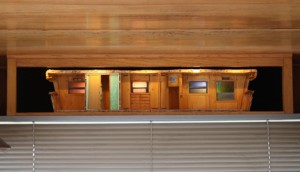
The ‘inside’ spartan model installed in the trailer at The Museum Of Jurassic Technology, Culver City CA
My proposal for models inside the trailer was to honor and reference ‘The Garden of Eden on Wheels’, and the ongoing conversation about trailer life at the Museum, while bringing the life of the Roger Brown trailer into focus in parallel to it. While preparing the Hyde Park exhibit I had begun construction of a model representing the South East interior corner of the La Conchita house, complete with replicas in miniature of the collection, furniture and objects and decided that unlike the other previous models which now reside at the Roger Brown Study Collection and function as interpretative material, this new corner model should be installed in the television cabinet that faces the dining and living area of the trailer. This particular closet interested me because it can be accessed from two directions by two doors that are at right angles to each other. In my previous Fall residency I had also begun to devise two more models but this time of the trailer itself. My intention here was to install these trailer models at either end of the trailer, in each of the long niche like shelves that span the narrow space above the end windows. Having begun with a series of scale drawings and models as sketches in the Fall, the two trailer models are now completed and installed also. Each model shows the Spartan trailer as an object in its own right, split in half length-ways, one model depicts the interior East side of the trailer, while the other shows the west outer face. The constructions were made in wood and metal utilizing as closely as possible replica scale materials at one inch to one foot.
http://www.youtube.com/watch?v=1aFPY0hyLnw&list=UULDxyAxwLgx2S1yMowwWJ9g&index=7&feature=plcp
For more details on all of these projects please visit my Sabbatical blog pages –
http://ruftydog.wordpress.com/
Nicholas Lowe, June 2012
Posted in ALL THE NEWS on Tuesday, June 26th, 2012
At nearly 125 years old the storefront doors and the apartment door at 1926 N. Halsted St. were perhaps the most used and abused element of the building. Having been opened and closed by countless people over the years, they had lost much structural integrity and were just plain worn out. The building had settled unevenly, both horizontally and laterally, and the north door had become almost comically out of square. Facing east, the surfaces had been taken the full force of the weather and were seriously deteriorated. The restoration project was undertaken by Neal Vogel / Restoric LLC with master carpenter Andy De LaRosa and Steve De LaRosa, and painted surfaces by Anthony Kartsonas.
 Storefront doors before restoration
Storefront doors before restoration
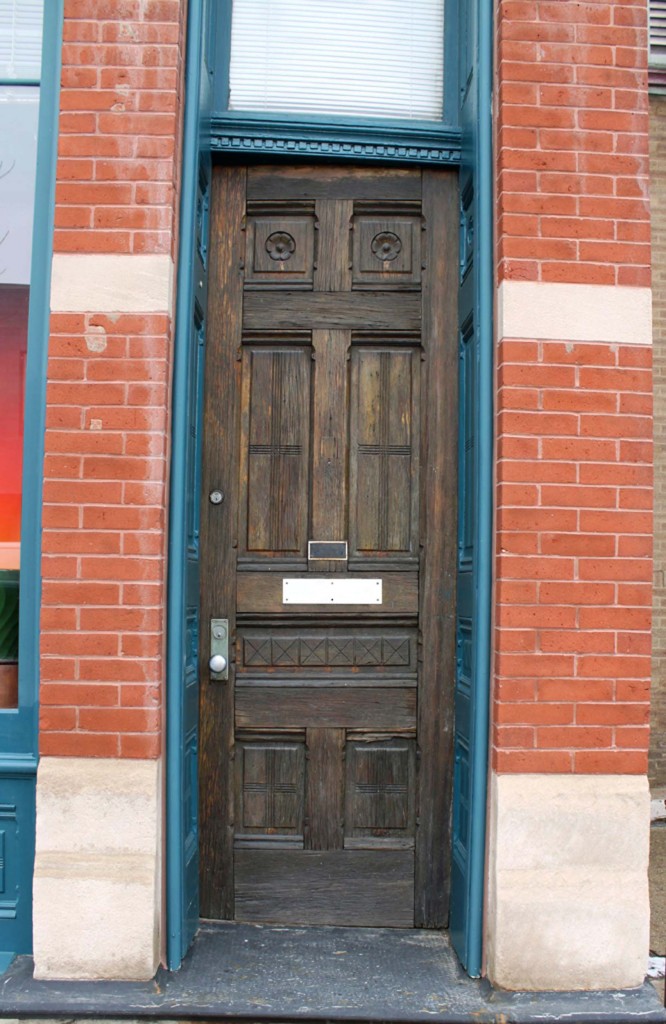 Apartment door before restoration
Apartment door before restoration
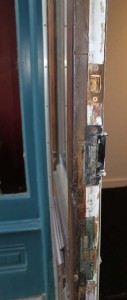 Locking hardware before restoration
Locking hardware before restoration
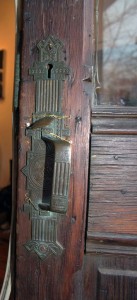 Storefront lock before restoration
Storefront lock before restoration
Like many projects to restore historic buildings, the plan seems finite at the outset and changes considerably once the project begins. The goal was to preserve, rather than replicate, all three doors and to make them structurally sound, with a surface that would hold up to the weather as long as possible. We didn’t anticipate that the apartment door frame had to be completely rebuilt, requiring modification of the carved entry panels, and modifications to the doors to accommodate for the movement of the building, so when the door is closed the opening is sealed.
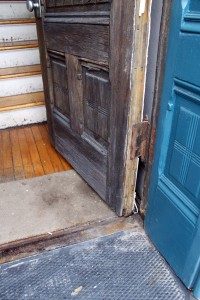 Apartment door hinge and profile before restoration
Apartment door hinge and profile before restoration
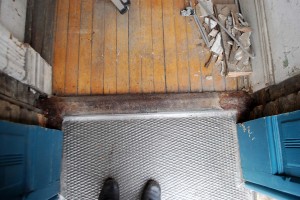 Apartment door modifications, detail.
Apartment door modifications, detail.
The apartment door and both storefront doors were found to be two doors sandwiched together, each. Andy De LaRosa explained that in the 1880s there was an abundance of wood and labor and it made sense to strengthen the doors by sandwiching two together. Using the available technology of the time, the inner and outer doors were held together by screws, no adhesive was used, a system which eventually failed, causing the doors to separate. The shifting of the door planes away from the original orientation presented the challenge of how to respect the original construction while restoring the doors to 21st century needs and goals.
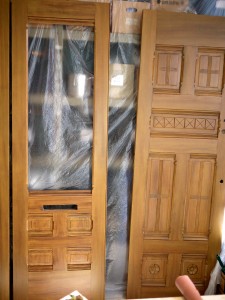 Painted doors ready for installation
Painted doors ready for installation
The original hardware had long since ceased to operate and various add-on hardware had been installed over the years. De LaRosa restored the remaining original hardware to functionality, installed new locking hardware. A new threshold was installed to prevent moisture from entering, as the cast iron porch tilts downward.
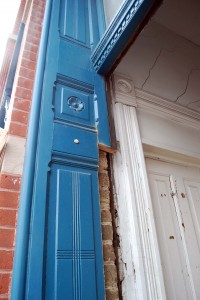 Apartment door modification for new frame
Apartment door modification for new frame
Some of the stile, panel, and rail wood had deteriorated beyond repair and had to be replaced on all three doors, so the exterior surfaces, which were unpainted, had to be painted to unify the surfaces. We preserve the building to the period Roger Brown lived and worked here, 1974 to 1995. We have but a single color photo of the building from that period, showing wood that had most likely been stripped. Tony Kartsonis applied the gorgeous, warm-toned wood grain finish.
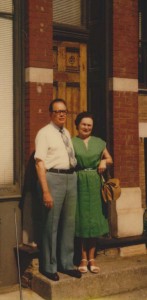 Roger Brown’s parents at apartment door, c. 1975, showing color of unpainted door.
Roger Brown’s parents at apartment door, c. 1975, showing color of unpainted door.
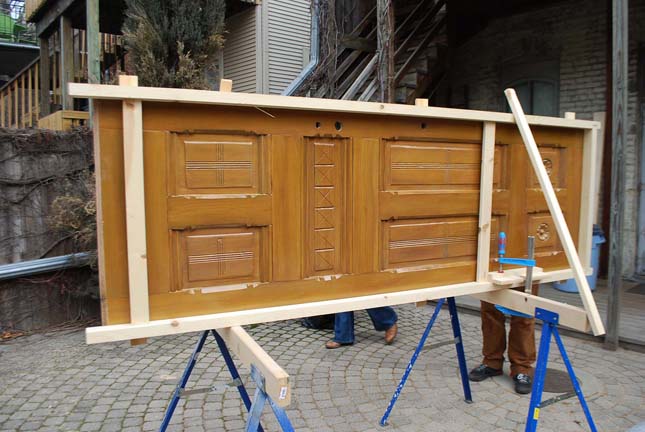 Apartment door prepared for installation
Apartment door prepared for installation
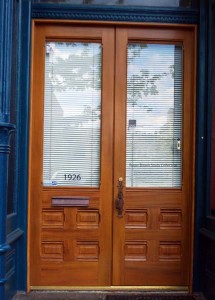 Storefront doors restored
Storefront doors restored
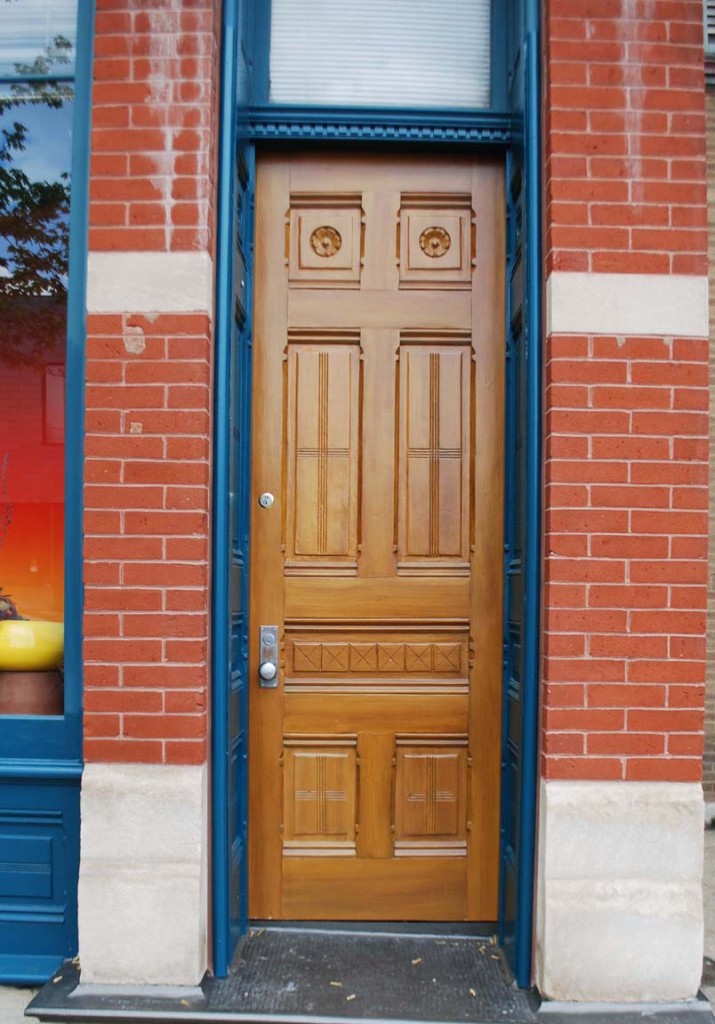 Apartment door restored
Apartment door restored
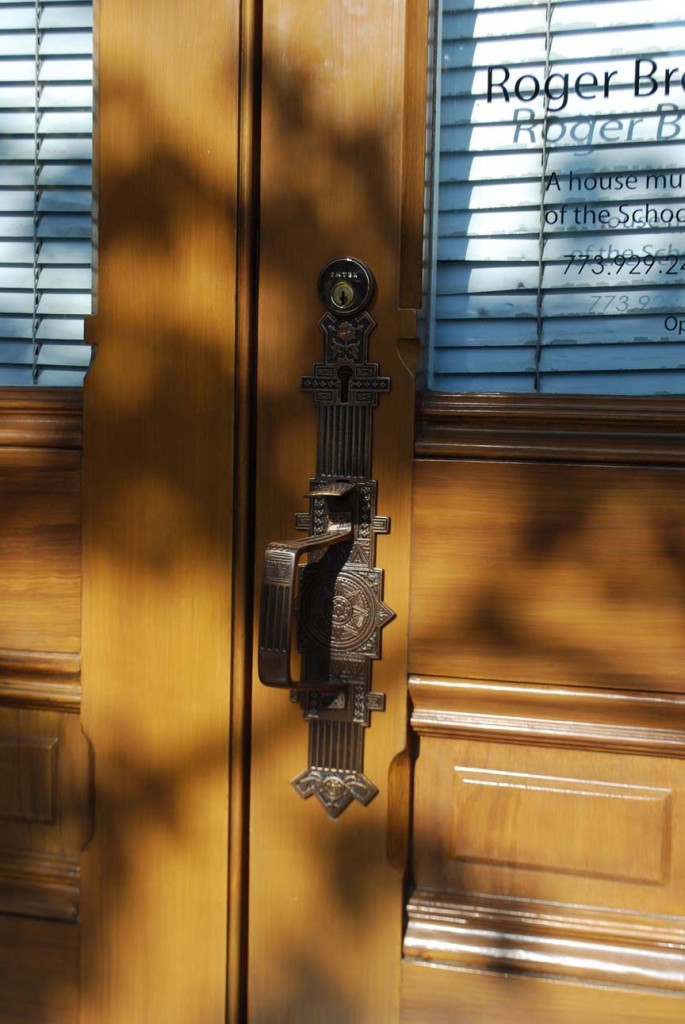
Restoric and De LaRosa shoot for at least 150 years of serviceable life until the job has to be done again. The doors––a large measure of our face to the street––are fully restored to functionality and a renewed, refreshed appearance, ready for their next century. Our thanks go out to Restoric, the De LaRosa team, and Tony Kartsonis. This project was funded by a generous donation from the Walter and Karla Goldschmidt Foundation, to whom we are especially grateful.
Lisa Stone, June 2012
Posted in Uncategorized on Tuesday, May 29th, 2012
I began working at the Roger Brown Study Collection (RBSC) in Fall 2010, which was also my first semester as a grad student at SAIC’s Dual Degree Program in Modern Art History, Theory, and Criticism and Arts Administration and Policy. In the winter of 2010, as a TA at the RBSC, I worked on a project to create high resolution scans of Roger Brown’s work from the early 1970s to 1997, nearly 900 images. The privilege of intimately studying each artwork became an engrossing experience, altering my understanding of Brown’s work on a monumental level. Spending hours scanning and editing, I began to notice that the subject of sexuality was a steady current running throughout Brown’s entire career. The ripple effect of that early observation has led me on a two-year professional and academic exploration into the subject of sexuality in Brown’s life and work, the result of which is the upcoming exhibition, Roger Brown: This Boy’s Own Story, opening August 25th 2012 at SAIC’s Sullivan Gallery’s.
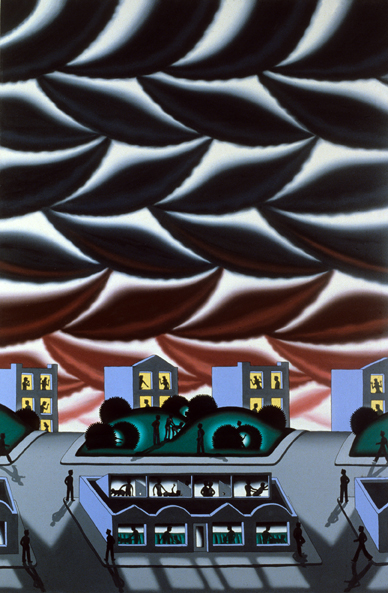 Roger Brown, City Nights: All-You-Wanted-to-Know-or-Don’t-Want-to-Know-and-were-Afraid-to- Ask A Closet Painting (subtitle supplied by Barbara Bowman, 1978, oil on canvas, 72 x 48 in. Roger Brown Estate Painting Collection, the School of the Art Institute of Chicago. Photograph: William H. Bengtson.
Roger Brown, City Nights: All-You-Wanted-to-Know-or-Don’t-Want-to-Know-and-were-Afraid-to- Ask A Closet Painting (subtitle supplied by Barbara Bowman, 1978, oil on canvas, 72 x 48 in. Roger Brown Estate Painting Collection, the School of the Art Institute of Chicago. Photograph: William H. Bengtson.
Brown’s early paintings and sculptures from the 1970s often depict landscapes and architectural scenes that are inlayed with silhouetted figures engaging, witnessing, or responding to sexual acts. In many works the landscapes themselves, or landscapes and features within them, are compositionally erotic in nature.
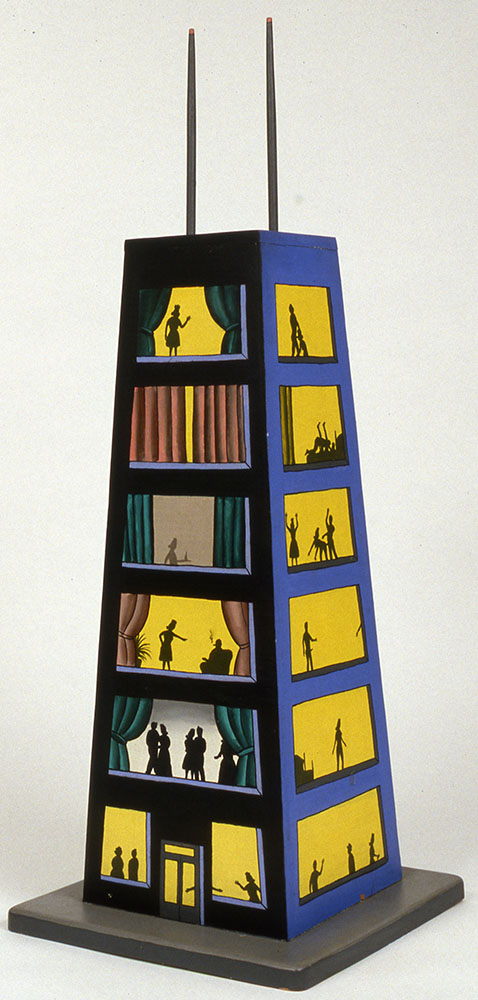 Roger Brown, Hancock Building, 1974, sculpture, oil on wood, 30 ½ x 12 x 11 ½ in. Roger Brown Study Collection, the School of the Art Institute of Chicago. Photograph: William H. Bengtson.
Roger Brown, Hancock Building, 1974, sculpture, oil on wood, 30 ½ x 12 x 11 ½ in. Roger Brown Study Collection, the School of the Art Institute of Chicago. Photograph: William H. Bengtson.
Brown’s works from the 1980s and 90s, like the painting shown below, boldly confront cultural prejudices about homosexuality and HIV and the cultural attack on gay culture and life.
 Roger Brown, Aha! Heterosexuals Fuck Too, 1991, oil on canvas, 72 x 72 in. Roger Brown Estate Painting Collection, the School of the Art Institute of Chicago. Photograph: William H. Bengtson.
Roger Brown, Aha! Heterosexuals Fuck Too, 1991, oil on canvas, 72 x 72 in. Roger Brown Estate Painting Collection, the School of the Art Institute of Chicago. Photograph: William H. Bengtson.
Part of my early academic scholarship in this project derived from a graduate class on Queer Theory, lead by Frederic Moffet, where my research concentrated on the final ten years of Brown’s life, specifically through studying the extensive archival materials at the RBSC and their relationship to his work. Inspired from that early research, Roger Brown: This Boy’s Own Story includes archival materials that provide deeper insight into the works that will be on view. I see this exhibition as a means to let the challenges and questions found in the archive and artworks have voice, so that the SAIC and Chicago community can reshape the layers of conversations that Roger Brown’s work evokes. I intend to use this blog as an incubator for further discussion about artist’s house museums, archives, and the borderlines (or lack there of) between public and private life.
An important component to this project is my search for some of Brown’s paintings in private collections that we currently lack information about. Calling this my “most wanted” list- I hope that if anyone reading this blog is the proud owner of any of the Roger Brown’s listed below they will contact the Roger Brown Study Collection, rbsc@saic.edu!
“Most Wanted” Roger Brown Works in Private Collections
 Roger Brown, This Boy’s Own Story: The True and Perfect Love, 1993, oil on canvas, 36 x 48 in. Private Collection. Photograph: William H. Bengtson.
Roger Brown, This Boy’s Own Story: The True and Perfect Love, 1993, oil on canvas, 36 x 48 in. Private Collection. Photograph: William H. Bengtson.
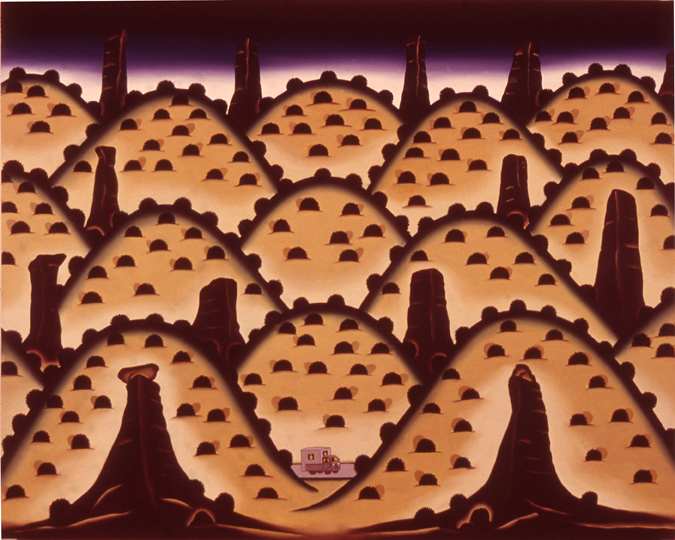 Roger Brown, New Mexican Vacation, 1973, oil on canvas, 48 x 60 in. Private Collection. Photograph: William H. Bengtson.
Roger Brown, New Mexican Vacation, 1973, oil on canvas, 48 x 60 in. Private Collection. Photograph: William H. Bengtson.
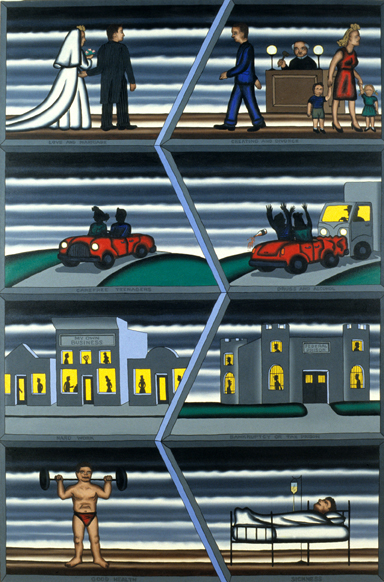 Roger Brown, It’s a Wonderful Lie, 1991, oil on canvas, 48 x 72 in. Private Collection. Photograph: William H. Bengtson.
Roger Brown, It’s a Wonderful Lie, 1991, oil on canvas, 48 x 72 in. Private Collection. Photograph: William H. Bengtson.
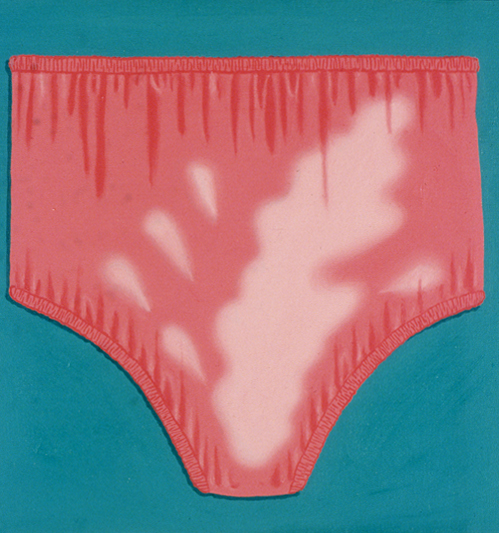 Roger Brown, An 11 ½” Semen Stain, 1985, oil on canvas, 15 x 15 in. Private Collection. Photograph: William H. Bengtson.
Roger Brown, An 11 ½” Semen Stain, 1985, oil on canvas, 15 x 15 in. Private Collection. Photograph: William H. Bengtson.
2012 is an exciting year for Roger Brown, and along with Lips of Gossip at Sullivan Galleries, Roger Brown’s work will be on view concurrently at three other exhibitions in Fall 2012:
Skyscraper: Art and Architecture Against Gravity at the Museum of Contemporary Art, Chicago,
Roger Brown: Important Paintings, at both Russell Bowman Art Advisoryand Zolla/Lieberman Gallery, Chicago.
Afterimage, DePaul Art Museum, September 15 – November 18, 2012.
This blog is going to be an ongoing place to chronicle, ponder, and celebrate the process leading up to the opening of Lips of Gossip, so spend the summer with me and visit again soon.
By: Kate Pollasch
« Older Entries Newer Entries »
 Jim Elniski and Research Studio students
Jim Elniski and Research Studio students Tim Parsons and Dan Price, Thing Lab students at work
Tim Parsons and Dan Price, Thing Lab students at work Performing the Document students Kurt Peterson and Jenny Kim
Performing the Document students Kurt Peterson and Jenny Kim Stephanie Krim creates a collection hoax
Stephanie Krim creates a collection hoax Gunter Baumann’s all-day postcard generating machine.
Gunter Baumann’s all-day postcard generating machine.
 left to right, works by Haley Hodge, Doris Richardson (top), Katie Doyle (bottom), and Aileen Berg.
left to right, works by Haley Hodge, Doris Richardson (top), Katie Doyle (bottom), and Aileen Berg. Modeling for Sculpture in action.
Modeling for Sculpture in action. Installation view, Ray Yoshida’s Museum of Extraordinary Values, John Michael Kohler Arts Center, Sheboygan, WI, through January 19, 2014.
Installation view, Ray Yoshida’s Museum of Extraordinary Values, John Michael Kohler Arts Center, Sheboygan, WI, through January 19, 2014. The Wildgoose Memorial Library
The Wildgoose Memorial Library






























































































































